2. 吉林大学地球科学学院, 长春 130061;
3. 中国海洋大学海洋地球科学学院, 海底科学与探测技术教育部重点实验室, 青岛 266100;
4. 青岛海洋科学与技术国家实验室海洋矿产资源评价与探测技术功能实验室, 青岛 266100
2. College of Earth Sciences, Jilin University, Changchun 130061, China;
3. MOE Key Lab of Submarine Geosciences and Prospecting Techniques, College of Marine Geosciences, Ocean University of China, Qingdao 266100, China;
4. Laboratory for Marine Mineral Resources, Qingdao State Laboratory for Marine Science and Technology, Qingdao 266100, China
大兴安岭位于中亚造山带东段,北侧以鄂霍茨克缝合带为界与西伯利亚板块相邻,南侧以索伦科尔-西拉木伦-长春缝合带为界与华北板块相接(图 1a, b),是区域构造演化历史中的一个重要地质单元,对整个中亚造山带的构造演化及增生历史研究具有重要意义(徐备等, 2014; Liu et al., 2017; Şengör et al., 1993; Şengör AMC and Natal’in, 1996; Windley et al., 2007; Xiao et al., 2009, 2010, 2015)。该区自北向南以此跨越额尔古纳、兴安和松嫩三个地块(徐备等, 2014; Feng et al., 2015; Liu et al., 2017; 图 1b)。其中,额尔古纳地块与兴安地块以新林-喜桂图缝合带为界,于早古生代~500Ma时期碰撞拼贴(徐备等, 2014; Liu et al., 2017)。该条缝合带以新林蛇绿岩、塔源辉长岩、吉峰蛇绿岩、头道桥蓝片岩等为标志,空间展布特征较为清晰。同时,许多学者通过对这些岩石或岩石组合的研究(李瑞山, 1991; 叶慧文等, 1994; 胡道功等, 1995; 吴福元等, 1999; 钟辉和付俊彧, 2006; 刘永江等, 2010),对该条缝合带的形成时间、成因机制和演化特征等方面也取得了较为深入的认识。而不同学者对兴安地块与松嫩地块之间碰撞缝合带的空间位置(徐备等, 2014; Liu et al., 2017)及形成时间(孙德有, 2001; 赵院冬等, 2009, 2013; 周长勇等, 2005; Feng et al., 2015, 2018; Liu et al., 2017; Ma et al., 2018; Wu et al., 2002)等问题的认识目前仍存在争议。一些研究表明,位于中亚造山带东部的兴蒙造山带早古生代存在古亚洲洋洋壳的俯冲作用,而在早古生代末期大洋闭合,晚古生代处于碰撞后的伸展作用(徐备等, 2014; Xu et al., 2015; Zhao et al., 2016, 2017),因此兴安地块与松嫩地块于晚古生代之前发生碰撞缝合。而沿艾力格庙、苏尼特左旗南、锡林浩特南和大石寨地区到黑河一线分布的早古生代岩浆岩、混杂岩和磨拉斯盆地等标志说明艾力格庙-锡林浩特-黑河一线为该两个地块的最终碰撞缝合线(徐备等, 2014; Xu et al., 2015; Zhao et al., 2016, 2017)。另一些研究表明,沿贺根山-黑河一线呈现出早石炭世“北海南陆”而晚石炭世“南海北陆”的古地理格局变化特征,说明贺根山-黑河为一条重要的构造带(刘永江等, 2011; Liu et al., 2017)。而沿该条构造带又识别出有早古生代(ca.480~420Ma)及晚古生代早石炭世(ca.360~330Ma)岩浆弧,结合多宝山岛弧、嫩江角闪岩相钠质糜棱岩、蘑菇气辉长岩及贺根山蛇绿岩的研究认为,兴安地块与松嫩地块沿贺根山-黑河一线发生最终的碰撞缝合(Liu et al., 2017; Feng et al., 2018; Ma et al., 2018)。同时,沿该条缝合带早石炭世时期有大量俯冲相关的I型花岗岩,晚石炭世出现有S型及A型花岗岩,说明兴安地块与松嫩地块最晚于晚石炭世之前发生碰撞缝合(Liu et al., 2017; Feng et al., 2018; Ma et al., 2018)。这些争议产生的一个很重要原因就在于从黑河地区向南经过的大兴安岭中段地区缺少岩石学证据的时空约束,进而造成缝合带南延的认识不同和碰撞闭合时间的争议。而过去一直没有大兴安岭中部地区与缝合带相关的明确证据报道,该区研究相对薄弱,因此,急需对大兴安岭中段地区开展深入系统的研究。
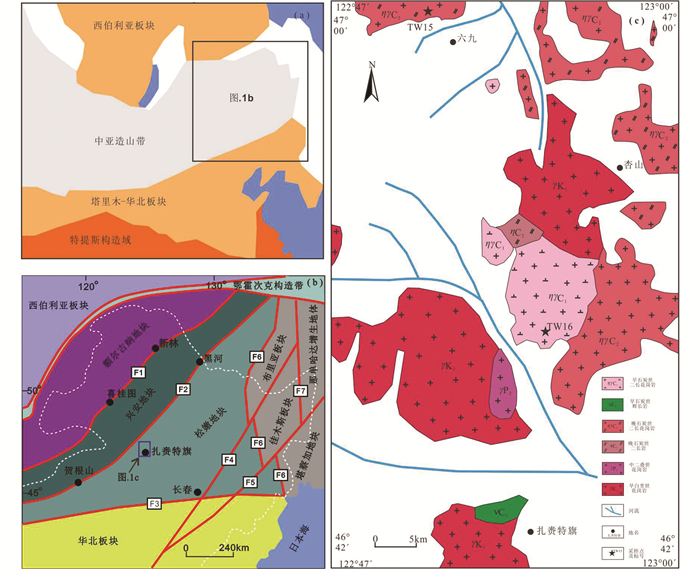
|
图 1 中亚造山带及邻区构造简图(a)、大兴安岭及邻区构造单元划分简图(b, 据刘永江等, 2010; Zhou and Wilde, 2013)和研究区晚古生代及中生代侵入岩地质简图(c, 据周志广等, 2013①) F1:新林-喜桂图缝合带;F2:贺根山-黑河缝合带;F3:索伦科尔-西拉木伦-长春缝合带;F4:依兰-伊通断裂;F5:敦化-密山断裂;F6:牡丹江断裂;F7:跃进山断裂 Fig. 1 Simplified tectonic framework of Central Asia Orogenic Belt and surround areas (a), tectonic division of the Great Xing'an Range and surround areas (b, modified after Liu et al., 2010; Zhou and Wilde, 2013) and Paleozoic and Mesozoic intrusive geological map of the studied area (c) F1: Xinlin-Xiguitu Suture; F2: Hegenshan-Heihe Suture; F3: Solonker-XarMoron-Changchun Suture; F4: Yilan-Yitong Fault; F5: Dunhua-Mishan Fault; F6: Muduanjiang Fault; F7: Yujinshan Fault |
① 周志广, 柳长峰, 於炀森等. 2013. 1:25万乌兰浩特市幅区域地质调查.北京:全国地质资料馆
近些年的区域地质调查在大兴安岭中段地区发现了大量的石炭纪花岗质侵入岩,这些岩石中蕴含着大量地质演化信息,详细的岩石成因及构造背景研究不仅有助于约束贺根山-黑河缝合带的具体形成时间,而且对理解区域构造演化历史及中亚造山带增生机制等科学问题均有重要的参考价值。因此,本研究以大兴安岭中段扎赉特旗地区石炭纪花岗岩为研究对象,通过岩石学、地球化学及年代学的研究来分析:1)花岗岩形成的精确年龄;2)岩石成因;3)岩石形成的构造背景及4)对中亚造山带增生机制的制约。
1 区域地质背景研究区位于大兴安岭中段扎赉特旗地区,大地构造位置上属松嫩地块西缘中部,西侧以贺根山-黑河缝合带为界与兴安地块相邻(图 1b)。兴安地块主体由古生代花岗质岩石及火山岩、沉积岩地层组成,之后又被中生代火山岩破坏或沉积岩覆盖(刘永江等, 2010; Ying et al., 2010; Wu et al., 2011)。有关兴安地块的基底问题目前仍存在争议。传统上认为其存在统一的前寒武纪变质基底和后期的盖层(Liu et al., 2017),而后来的年代学研究发现这些“前寒武纪变质基底”多为古生代地质体,测年结果普遍偏新(杨现力, 2007; 周建波等, 2014; Miao et al., 2007)。少量能够代表基底的前寒武纪变质岩石多分布于兴安地块东北部,而中部及南部尚未发现。故有关兴安地块基底的问题仍需进一步研究。
松嫩地块位于中国东北地区中部,大部分被松辽盆地中新生代沉积物所覆盖。最初,一些学者认为松嫩地块由前寒武纪变质基底与后期的盖层组成(李双林和欧阳自远, 1998; 叶慧文等, 1994; 葛梦春等, 2011),但缺少年龄的支持。后期的钻探岩芯测年结果表明,松嫩地块的基底由晚古生代-早中生代结晶岩石组成(吴福元等, 2000)。但后来松辽盆地钻出的变沉积岩中测出了两个前寒武纪年龄,预示其可能存在前寒武纪基底(梁爽等, 2009)。近几年来,随着研究的深入,在松嫩地块的东缘、南部及西缘均有早前寒武纪年龄的相关报道。例如:来自松辽盆地东缘的云母片岩显示出757±9Ma、843±10Ma的最小年龄峰值(权京玉等, 2013; Wang et al., 2014);在南部地区,裴福萍等(2006)从钻孔岩心中得到的火山角砾岩和变质辉长岩年龄分别为1808±21Ma和1873±13Ma;王颖等(2006)也报道了变质闪长岩SHRIMP锆石年龄为1839±7Ma;在松辽盆地西缘的龙江地区,Zhang et al. (2017)报道了1879±4Ma二长花岗岩(Zhang et al., 2017),这些数据表明松嫩地块应存在早前寒武纪基底。
由于该地块多数地区覆盖严重,目前有关其古生代地质研究的专题性报道相对较少,但在松嫩地块西缘出露相对好的地段有少量相关的晚古生代研究报道。Li et al. (2014)报道了位于松嫩-张广才岭地块西缘的晚古生代火山岩,认为该地块西缘地区的晚古生代岩浆活动可以分为三个期次:早石炭世(~351Ma)、晚石炭世早期(~319Ma)及早二叠世(295~293Ma)。早石炭世时期的岩浆活动处于被动陆缘环境下,有A型流纹岩的形成,预示了伸展的构造背景,该种伸展构造背景由于古洋壳向北侧兴安地块之下俯冲的同时对松嫩-张广才岭地块的拖拽所形成。晚石炭世早期的岩浆活动形成于板块汇聚的地壳加厚阶段,预示着兴安地块与松嫩地块碰撞拼贴事件的发生。而早二叠世的A型流纹岩则说明了兴安地块与松嫩地块碰撞缝合之后的伸展造山阶段(Li et al., 2014)。汪岩等(2013)报道了扎赉特旗地区的石炭纪辉长岩-闪长岩,包括早石炭世角闪辉长岩(328.3Ma)及闪长岩(325.3Ma)、晚石炭世辉绿岩(317.3Ma)等,并认为该套岩石的形成于与俯冲-消减作用有关的活动大陆边缘环境,类似于岛弧环境(汪岩等, 2013)。可见不同学者的研究对松嫩地块西缘石炭纪的构造背景有着不同的理解,有待更多的研究进一步开展。
传统上认为贺根山-黑河缝合带是兴安地块与松嫩地块之间的碰撞缝合带(刘永江等, 2011; Ma et al., 2018; Miao et al., 2007, 2008; Han et al., 2015; Liu et al., 2017; Jian et al., 2012),其南段有贺根山蛇绿岩为代表的古洋壳残余(白文吉等, 1985; Miao et al., 2007, 2008),北段有多宝山斑岩型铜矿为代表的多宝山岛弧(武广等, 2005),均为贺根山-黑河缝合带的研究提供了可靠的依据。但有研究表明贺根山蛇绿岩形成于软流圈上涌和岩石圈伸展有关的构造背景之下(Jian et al., 2010),不代表古大洋的残余。另一方面,早在晚泥盆世,贺根山蛇绿岩附近已经出现陆相磨拉斯建造,暗示晚泥盆世之后出现的陆相环境。因此,区域地质背景限定贺根山等地的早石炭世蛇绿岩应发育在陆壳基底之上,代表造山后的一次伸展过程(徐备等, 2014)。而也有研究认为贺根山-黑河洋(位于兴安地块和松嫩地块之间的古亚洲洋分支)在晚石炭世之前尚未闭合,贺根山蛇绿岩形成于古洋盆闭合前的早石炭世时期(Miao et al., 2008; Jian et al., 2012),代表着主洋盆的古洋壳残留,并非弧后盆地或者重新拉开的局部洋盆(Liu et al., 2017)。可见,该条缝合带的属性问题仍存在较大争议,也需开展进一步的研究。
野外地质调查发现,研究区的早石炭世花岗质侵入岩分布较为局限,而晚石炭世花岗质侵入岩则广泛出露(图 1c)。同时,南部地区可见小规模的晚石炭世镁铁质侵入体,主要岩性为辉长岩。研究区中部地区也出露有二叠纪花岗质侵入体,但岩体规模不大(图 1c)。古生代岩石多数遭受中新生代岩浆事件的严重破坏与火山岩或沉积岩的覆盖。
2 样品描述本次研究的石炭纪花岗岩包括位于研究区中部的早石炭世二长花岗岩(46°51′32″N、122°55′22″E)和北部的晚石炭世二长花岗岩(46°59′51″N、122°51′16″E)(图 1c)。其中早石炭世二长花岗岩侵入体规模较大,但大部分被后期沉积物所覆盖。通过岩体不同部位的天然露头或采石坑中的人工露头观测发现,该岩体不同部位岩石的矿物成分、含量、颗粒大小等变化均较小,说明该岩体在空间上较为均一稳定。近地表的岩石绝大多数较为松散,大部分已成为风化砂。晚石炭世二长花岗岩侵入体规模也较大,遭受后期沉积物覆盖也较为严重,且整个岩体的岩性特征也较为均一稳定。但岩石多呈坚硬的块状出露,岩体遭受后期构造破坏作用较强,很多部位的岩石被错断为大小不一的岩块。两个岩体代表性岩石描述如下:
早石炭世二长花岗岩(TW16)(图 2a-c):岩石呈浅灰白色,不等粒结构,块状构造。野外露头处可见岩石均较为破碎,并普遍发育显著的呈“层状”的原始节理。矿物成分主要为石英(~30%),他形粒状,粒径2~5mm;斜长石(~35%),呈自形板片状,聚片双晶发育,聚晶一般较大,约5~15mm;钾长石(~25%),自形-半自形,粒径5~8mm;白云母(~8%),呈片状,颗粒均较小,约0.5~4mm;少量黑云母(~2%),片状,粒径1~3mm。多数矿物遭受碎裂作用出现裂痕。
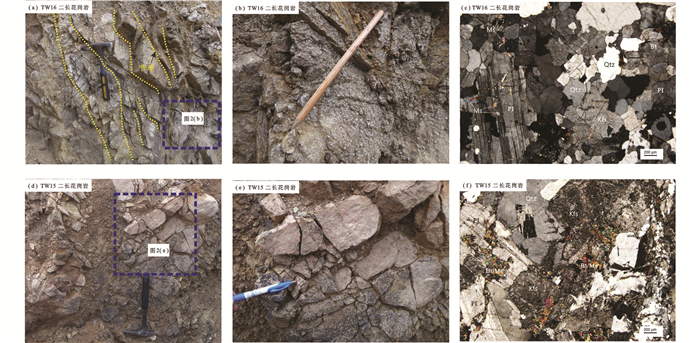
|
图 2 扎赉特旗地区早石炭世二长花岗岩(TW16)(a-c)和晚石炭世二长花岗岩(TW15)(d-f)野外露头及镜下照片 Pl-斜长石;Kfs-钾长石;Qtz-石英;Ms-白云母;Bt-黑云母 Fig. 2 Field occurrence and microscope of the Early Carboniferous monzogranite (TW16) (a-c) and Late Carboniferous monzogranite (TW15) (d-f) in Jalaid Banner Pl-plagioclase; Kfs-K-feldspar; Qtz-quartz; Ms-muscovite; Bt-biotite |
晚石炭世二长花岗岩(TW15)(图 2d-f):岩石呈肉红色、浅肉红色,不等粒结构,块状构造。矿物成分主要为石英(~25%),他形粒状,粒径2~10mm;斜长石(~20%),自形-半自形,板柱状,粒径3~8mm;钾长石(~45%),自形-半自形,短柱状,粒径2~5mm;白云母及黑云母(~10%),自形-半自形,片状,颗粒极小,发育于矿物缝隙中或者斜长石中,为次生矿物。副矿物包括磷灰石、锆石及榍石。
3 分析方法锆石挑选、制靶及阴极发光图像采集在廊坊市宇能岩石矿物分选技术服务有限公司完成。U-Pb年龄测定工作在中国科学院海洋研究所完成。测试仪器采用Thermo Element Ⅱ及New Wave UP213激光剥蚀系统,实验激光束斑直径为32μm,频率为10Hz,激光能量为0.09J,采用高纯氦气作为剥蚀物质的载气,每个分析点的气体背景采集时间为30s,信号采集时间为40s。使用人工合成硅酸玻璃标准物质NIST610进行仪器状态调整参考,使用国际标准锆石91500作为同位素组成的外标。测试结果通过GLITTER4.0软件计算获得,普通Pb校正采用Andersen (2002)的方法进行,锆石谐和图采用Isoplot3.0绘制。详细实验步骤和分析方法请参考Yuan et al. (2004)。
主量元素、微量和稀土元素的分析测试由国土资源部沈阳矿产资源监督检测中心完成。主量元素使用X射线荧光光谱仪(XRF-1500)完成分析测试。微量元素、稀土元素分析使用等离子体质谱仪(ICP-MS)ELEMENT Ⅱ测试完成。
锆石原位微区Hf同位素在南京大学内生金属矿床成矿机制研究国家重点实验室测试,所用仪器为Neptune-Plus“多接受等离子质谱仪”(MC-ICPMS)和GeoLas2005激光剥蚀系统。锆石Hf同位素测试在锆石U-Pb定年相同的分析位置进行。测试过程中,激光束直径为44μm,激光脉冲频率为6Hz。整个测试以91500、GJ-1和Monastery作为标样监测数据质量。标样91500的176Hf/177Hf测试结果为0.282291±35(2σ,n=89),GJ-1的176Hf/177Hf测试结果为0.282019±4(2σ,n=87),均在误差范围内与推荐值一致(Woodhead and Hergt, 2005)。详细的仪器分析条件和数据获取方法见文献(Liu et al., 2010)。εHf(t)值依据测点的锆石U-Pb年龄来计算,采用176Lu衰变常数为1.876×10-11y-1(Söderlund et al., 2004),球粒陨石176Hf/177Hf比值为0.282785,176Lu/177Hf比值为0.0336(Bouvier et al., 2008)。采用现今亏损地幔176Hf/177Hf及176Lu/177Hf的比值来计算锆石Hf同位素的一阶段模式年龄(tDM1(Hf)),其中176Hf/177Hf=0.28325,176Lu/177Hf=0.0384(Griffin et al., 2000)。假设每颗锆石的母岩浆来自平均大陆地壳,采用176Lu/177Hf比值为0.015(Griffin et al., 2002)计算锆石Hf同位素的二阶段模式年龄(tDM2(Hf))。选择不同衰变常数不会影响实验结果。
4 分析结果 4.1 锆石测年结果本文对扎赉特旗地区早石炭世二长花岗岩(TW16)和晚石炭世二长花岗岩(TW15)2件样品分别进行锆石U-Pb测年(表 1)。
|
|
表 1 扎赉特旗地区早石炭世二长花岗岩(TW16)与晚石炭世二长花岗岩(TW15)LA-ICP-MS U-Pb定年结果 Table 1 Zircon LA-ICP-MS U-Pb data of the Early Carboniferous monzogranite (TW16) and Late Carboniferous monzogranite (TW15) in Jalaid Banner |
对早石炭世二长花岗岩(TW16)的24颗代表性锆石进行年代学测试,多数锆石呈自形-半自形的柱状或短柱状特征,粒径大小多在80~150μm之间。绝大多数锆石具有明显的岩浆震荡环状特征(图 3a),Th/U比值(0.31~1.29;平均0.89)较高,为典型的岩浆锆石特点。少数锆石具有特征性的“核幔结构”,由岩浆锆石核部及后期的变质增生边组成。两颗锆石显示出较老的206Pb/238U年龄,分别为1732Ma和446Ma,可能为继承锆石或捕获锆石。在松嫩地块西缘的龙江地区有古元古代二长花岗岩岩体(1879Ma)的报道,是松嫩地块前寒武纪基底的代表(Zhang et al., 2017)。本文所报道的早石炭世二长花岗岩岩体位于该古元古代二长花岗岩岩体的南部邻区,则1732Ma的锆石很可能是岩浆上升过程中捕获的松嫩地块基底岩石中的锆石。其余22颗锆石206Pb/238U年龄值变化在326~363Ma之间,且均落在协和曲线上,加权平均年龄为334.1±5.9Ma(MSWD=1.8),为早石炭世中期,代表了该岩体的结晶年龄(图 4a)。
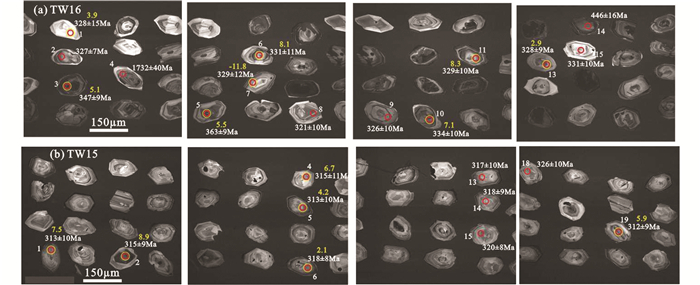
|
图 3 扎赉特旗地区早石炭世二长花岗岩(TW16)(a)和晚石炭世二长花岗岩(TW15)(b)代表性锆石阴极发光图像 白色及黄色圆圈分别表示了LA-ICP-MS U-Pb及Hf同位素测点位置 Fig. 3 Cathodoluminescence (CL) images of zircon grains from the Early Carboniferous monzogranite (TW16) (a) and Late Carboniferous monzogranite (TW15) (b) in Jalaid Banner White and yellow circles indicate the locations of LA-ICP-MS U-Pb dating and Hf analyses, respectively |
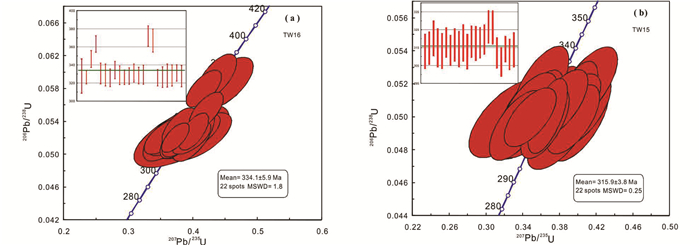
|
图 4 扎赉特旗地区早石炭世二长花岗岩(TW16)(a)和晚石炭世二长花岗岩(TW15)(b)锆石U-Pb年龄协和图 Fig. 4 Concordian U-Pb diagrams of the Early Carboniferous monzogranite (TW16) (a) and Late Carboniferous monzogranite (TW15) (b) in Jalaid Banner |
共对晚石炭世二长花岗岩(TW15)的22颗代表性锆石进行了测年,其特征与早石炭世二长花岗岩(TW16)的锆石较为相似,多呈浑圆状或近似圆状,少量呈短柱状,粒径在50~150μm之间,且均发育明显的岩浆震荡环状(图 3b)。锆石Th/U比值较高,介于0.6~1.2之间,平均值为0.79,是典型的岩浆锆石。锆石206Pb/238U年龄值变化在307~327Ma之间,均落于协和曲线之上,协和性较好。加权平均年龄为315.9±3.8Ma(MSWD=0.25),属晚石炭世早期,代表了二长花岗岩体的结晶年龄(图 4b)。

|
图 5 扎赉特旗地区早石炭世二长花岗岩(TW16)和晚石炭世二长花岗岩(TW15)主量元素图解 (a) SiO2-K2O图解;(b) A/CNK-A/NK图解. A/CNK=摩尔Al2O3/(Na2O+K2O+CaO),A/NK=摩尔Al2O3/(Na2O+K2O) Fig. 5 Major element diagrams of the Early Carboniferous monzogranite (TW16) and Late Carboniferous monzogranite (TW15) in Jalaid Banner (a) SiO2 vs. K2O diagram; (b) A/CNK vs. A/NK diagram. A/CNK=molar Al2O3/(Na2O+K2O+CaO), A/NK=molar Al2O3/(Na2O+K2O) |
早、晚石炭世二长花岗岩的SiO2含量均较高,分别介于71.64%~73.48%和71.68%~72.69%之间。早石炭世二长花岗岩的K2O(4.19%~4.65%)和全碱含量(ALK=8.22%~8.56%)较高(表 2),属于高钾钙碱性岩浆系列(图 5a)。而晚石炭世二长花岗岩的K2O(2.31%~2.95%)和全碱含量(ALK=7.36%~8.17%)相对较低,属于钙碱性岩浆系列(图 5a)。早石炭世二长花岗岩Al2O3(13.57%~14.04%)含量较高,铝指数(ASI)均大于1.1,属于强过铝质花岗岩(图 5b)。而晚石炭世二长花岗岩的铝指数(ASI)介于0.92~0.98之间,属于准铝质花岗岩(图 5b)。
|
|
表 2 扎赉特旗地区早石炭世二长花岗岩(TW16)和晚石炭世二长花岗岩(TW15)主量元素(wt%)和微量元素(×10-6)分析结果 Table 2 Major (wt%) and trace element (×10-6) compositions for the Early Carboniferous monzogranite (TW16) and Late Carboniferous monzogranite (TW15) in Jalaid Banner |
早石炭世二长花岗岩总稀土含量相对较高,∑REE=133.7×10-6~162.8×10-6,平均146.3×10-6(表 2)。轻重稀土分离明显,LREE/HREE=12.2~13.8,富集轻稀土元素(LREE=123.6×10-6~151.8×10-6)而亏损重稀土元素(HREE=10.0×10-6~11.0×10-6),稀土(REE)曲线呈现右倾模式(图 6a)。无明显的Eu异常(δEu=0.91~1.14),说明斜长石结晶分离不明显。晚石炭世二长花岗岩的稀土总量与轻重稀土分异特征与早石炭世二长花岗岩较为相似(图 6a),稀土总量较高(∑REE=80.4×10-6~103.5×10-6,平均94.5×10-6)。轻重稀土分离明显,LREE/HREE=8.4~9.7,呈现显著的右倾特征。但晚石炭世二长花岗岩具有显著正Eu异常(δEu=1.4~2.0),可能与斜长石的大量富集有关,其岩石薄片中也可见有较多的斜长石(图 2c)。在原始地幔标准化微量元素图解中(图 6b),早石炭世二长花岗岩与晚石炭世二长花岗岩均呈现出富集大离子亲石元素(LILEs:Rb、K、Ba)而亏损高场强元素(HFEs:Nb、Ti)及P元素的特征(图 6b)。但早石炭世二长花岗岩出现明显的负Sr异常,而晚石炭世二长花岗岩却没有这一特征,说明前者在结晶过程中有着斜长石的分异作用,而后者则没有。

|
图 6 扎赉特旗地区早石炭世二长花岗岩(TW16)和晚石炭世二长花岗岩(TW15)球粒陨石标准化稀土元素配分图(a)及原始地幔标准化微量元素蛛网图(b) Fig. 6 Chondrite-normalized REE patterns (a) and primitive mantle-normalized trace element spidergrams (b) for the Early Carboniferous monzogranite (TW16) and Late Carboniferous monzogranite (TW15) in Jalaid Banner |
对大兴安岭中段扎赉特旗地区早、晚石炭世二长花岗岩的部分代表性锆石分别进行了原位微区Hf同位素测试工作(表 3、图 3、图 7)。早石炭世二长花岗岩原始176Hf/177Hf比值在0.282235~0.282867之间,εHf(t)值在-11.8~10.3之间。一阶段模式年龄位于556~1426Ma之间,二阶段模式年龄在637~1863Ma之间(表 3、图 7)。晚石炭世二长花岗岩的原始176Hf/177Hf比值在0.282633~0.282836之间,εHf(t)值在介于2.1~8.9之间。一阶段模式年龄位于598~887Ma之间,二阶段模式年龄在701~1094Ma之间(表 3、图 7)。
|
|
表 3 扎赉特旗地区早石炭世二长花岗岩(TW16)和晚石炭世二长花岗岩(TW15)锆石Hf同位素特征 Table 3 Zircon Hf isotopic data of the Early Carboniferous monzogranite (TW16) and Late Carboniferous monzogranite (TW15) in Jalaid Banner |
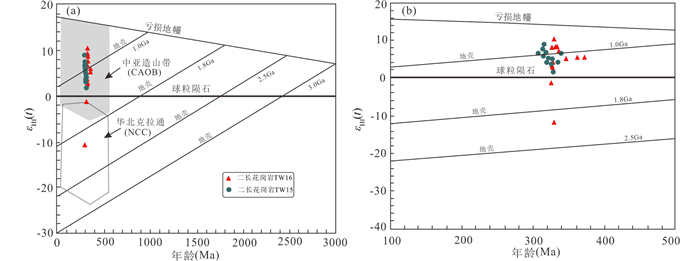
|
图 7 扎赉特旗地区早石炭世二长花岗岩(TW16)和晚石炭世二长花岗岩(TW15)Hf同位素特征与锆石年龄关系图 中亚造山带及华北克拉通数值参考Yang et al. (2006) Fig. 7 Correlations between Hf isotopic compositions and ages of zircons from the Early Carboniferous monzogranite and Late Carboniferous monzogranite in Jalaid Banner Fields for the Central Asian Orogenic Belt (CAOB) and North China Craton (NCC) are from Yang et al. (2006) |
研究表明,贺根山-黑河缝合带在大兴安岭中段地区沿嫩江-蘑菇气一带通过(Liu et al., 2017)。本文所报道的石炭纪二长花岗岩位于缝合带东侧的松嫩地块西缘地区,说明该区存在石炭纪岩浆活动,这与近几年松嫩地块西缘所报道的石炭纪侵入岩相符(汪岩等, 2013)。同时,最近开展的区域地质调查工作(周志广等, 2013)也在松嫩地块西缘识别出较多石炭纪侵入岩,说明该区石炭纪时期岩浆活动较为普遍。但石炭纪侵入岩主要分布于松嫩地块西缘临近贺根山-黑河缝合带的局部地区,并无向盆地内部延伸的趋势。空间上沿北东向在松嫩盆地西缘展布,受控于贺根山-黑河缝合带的构造活动(图 8)。
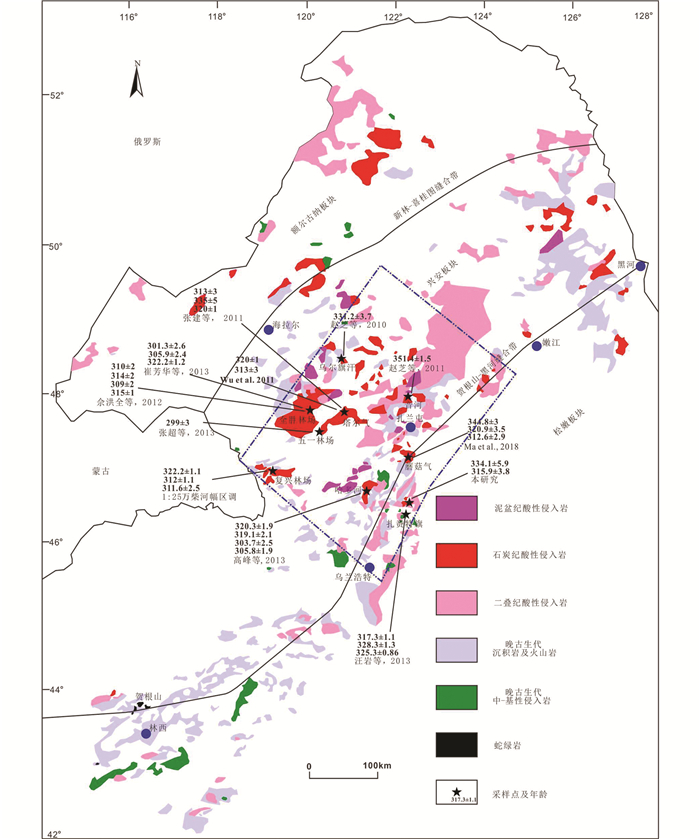
|
图 8 大兴安岭地区晚古生代地质简图 蓝色方框内标出了大兴安岭中段地区已发表的石炭纪侵入岩年龄,具体信息参考表 4 Fig. 8 Simplified Late Paleozoic geological map of the Great Xing'an Range The reported age data in the middle Great Xing'an Range (framed in the blue dashed box), more detailed information listed in the table 4 |
|
|
表 4 大兴安岭中段地区石炭纪侵入岩年龄统计表 Table 4 Carboniferous geochronologic data in the middle Great Xing'an Range |
缝合带以西的大兴安岭中段地区为兴安地块的腹部,早前的地质调查工作在该区发现有大量的石炭纪侵入岩(郑常青等,2013①),目前也已有诸多相关报道(图 8、表 4)。如:乌尔其汗岩体、音河岩体(334.2Ma, 351.4Ma, 赵芝等, 2010; 赵芝, 2011);塔尔气地区花岗质岩体(313~335Ma, Wu et al., 2011; 张健等, 2011);哈多河地区花岗质糜棱岩(303~320Ma, 高峰等, 2013);全胜林场地区花岗岩(301~322Ma, 崔芳华等, 2013; 佘宏全等, 2012);五一林场地区正长花岗岩(299Ma, 张超等, 2013);复兴林场地区花岗岩(郑常青等, 2013)及蘑菇气地区花岗质侵入岩等(312~344Ma, Ma et al., 2018)。说明石炭纪时期大兴安岭中段地区岩浆活动十分频繁。从地质填图及研究报道来看,兴安地块上的石炭纪侵入岩分布十分广泛,遍布于整个地块的大部分地区,且早石炭世侵入岩相对较少,具弧岩浆岩的特征,可构成岩浆弧(Liu et al., 2017; Zhang et al., 2018)。而晚石炭世时期的侵入岩呈面状分布特征,具I型或A型花岗岩的特征,与兴安地块和松嫩地块碰撞拼贴之后的后碰撞或者伸展构造活动有关(Feng et al., 2015; Ma et al., 2018)。
① 郑常青, 姚文贵, 孙忠实等. 2013. 1:25万柴河幅区域地质调查.北京:全国地质资料馆
5.2 岩石成因 5.2.1 早石炭世二长花岗岩本次研究的早石炭世二长花岗岩具有高的SiO2与全碱含量(ALK=8.22%~8.56%),显示出A型花岗岩的一些特征(Whalen et al., 1987; 图 9a, b)。然而,负Eu异常的缺失及轻重稀土的显著分异与区域上所报道的典型A型花岗岩有着明显的不同(吴福元等, 2007; Wu et al., 2002; Tong et al., 2015; Zhang et al., 2015; 图 9a),说明其并非A型花岗岩。在野外地质调查过程中发现,早石炭世二长花岗岩新鲜面颜色均较浅,多呈浅灰白色。并且普遍发育类似“层状”或“叶片状”的原生节理,与区域上呈现“块状”特征的I型或A型花岗岩形成鲜明的对比(图 2a, b)。这为S型花岗岩的典型岩石学特征(Chappell and White, 1992, 2001)。同时,该岩体具有较高的Al2O3含量,铝指数(ASI=1.20~1.23)均大于1.1,为强过铝质花岗岩(Sylvester, 1998),属S型花岗岩系列(Chappell and White, 1992, 2001)。对岩浆来源物质的分析中发现,其成岩岩浆来源于变沉积岩(包括变泥岩及变杂砂岩/硬砂岩)的部分熔融(图 10d、图 11),进一步说明早石炭世二长花岗岩为S型花岗岩。结合其强过铝质的特点,本研究认为其为强过铝质S型花岗岩。
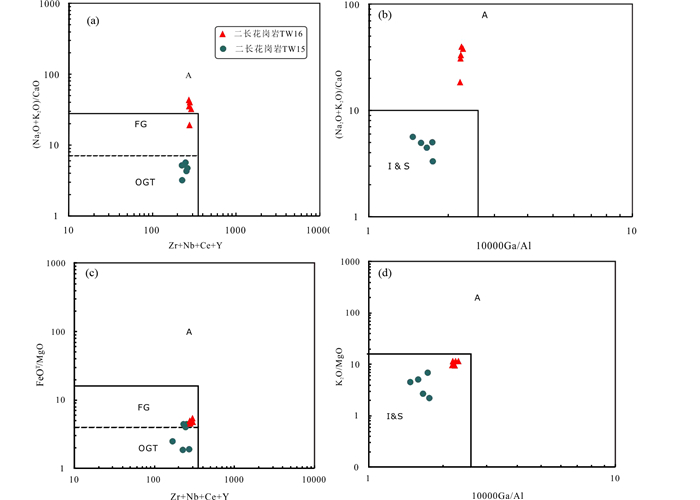
|
图 9 扎赉特旗地区早石炭世二长花岗岩和晚石炭世二长花岗岩岩石类型判别图解 (a) (Na2O+K2O)/CaO-(Zr+Nb+Ce+Y)图解;(b) (Na2O+K2O)/CaO-10000Ga/Al图解;(c) FeOT/MgO-(Zr+Nb+Ce+Y)图解;(d) K2O/MgO-10000Ga/Al图解(据Whalen et al., 1987). A=A型花岗岩区域;FG=分异的花岗岩区域;OGT=未分异的M-, I-和S-型花岗岩区域;I&S=I型和S型花岗岩区域 Fig. 9 Rock type discrimination for the Early Carboniferous monzogranite and Late Carboniferous monzogranite in Jalaid Banner (a) (K2O+Na2O)/CaO vs. (Zr+Nb+Ce+Y) diagram; (b) (K2O+Na2O)/CaO vs. 10000Ga/Al diagram; (c) FeOT/MgO vs. (Zr+Nb+Ce+Y) diagram; (d) K2O/MgO vs. 10000Ga/Al diagram (after Whalen et al., 1987); A=field for A-type granites; FG=Fractionated granites; OGT=unfractionated M-, I-, and S-type granites. I & S=field for I- and S-type granites |

|
图 10 扎赉特旗地区早石炭世二长花岗岩和晚石炭世二长花岗岩成因环境图解 (a)泥质岩脱水熔融实验CaO/Na2O-Al2O3/TiO2图解(Sylvester,1998);(b)锆石饱和温度图;(c)典型造山带强过铝质花岗岩Rb/Sr-Rb/Ba图解;(d)低CaO/Na2O比值(< 0.3)与高CaO/Na2O比值(> 0.3)强过铝质花岗岩Rb/Sr-Rb/Ba图解.以上图解中各典型造山带数据来源可参考Sylvester (1998)的总结 Fig. 10 Genetic condition diagrams for the Early Carboniferous monzogranite and Late Carboniferous monzogranite in Jalaid Banner (a) CaO/Na2O vs. Al2O3/TiO2 ratios for experimental vapor-absent melts of natural pelite (Sylvester, 1998); (b) Zr saturation temperature diagram; (c) Rb/Sr vs. Rb/Ba ratios for post-collisional SP granite intrusions subdivided on the basis of classic orogen; (d) Rb/Sr vs. Rb/Ba ratios for post-collisional SP granite intrusions subdivided on the basis of low and high CaO/Na2O ratio.The reference data of classical orogenic belts in the diagrams above are the same as Sylvester (1998) |
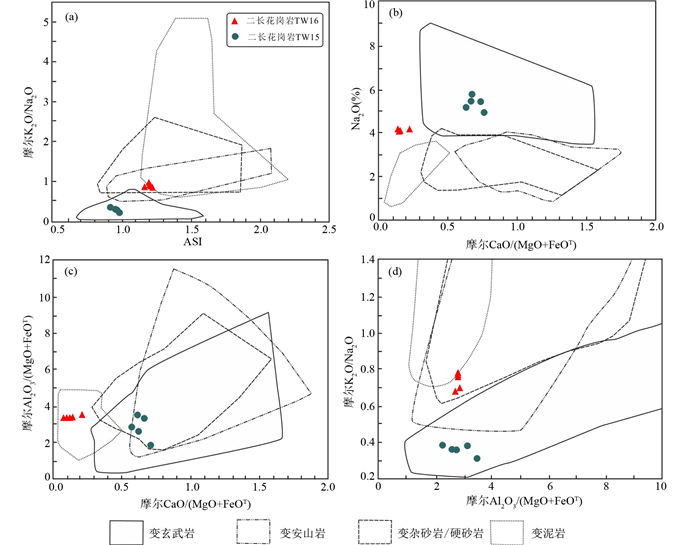
|
图 11 不同岩石类型脱水熔融实验成分分布特征图 图中界定各区域的数据来源:Vielzeuf and Holloway (1988); Patiño Douce and Johnston (1991); Rapp et al. (1991); Gardien et al. (1995); Rapp (1995); Rapp and Watson (1995); Patiño Douce and Beard(1995, 1996); Stevens et al. (1997); Skjerlie and Johnson (1996); Patiño Douce, (1997); Patiño Douce and McCarthy (1997) Fig. 11 Compositional fields of experimental melts derived from dehydration melting of various bulk compositions |
据Sylvester (1998)的研究,强过铝质S型花岗岩的成岩条件可通过其地质特征和地球化学组成来区分,尤其是CaO/Na2O及Al2O3/TiO2比值,Rb-Sr-Ba体系等(Sylvester, 1998)。本研究中的早石炭世二长花岗岩Al2O3/TiO2介于45.87~48.89之间,根据Patiño Douce and Johnston (1991)、Patiño Douce and Beard (1995)及Skjerlie and Johnston (1996)等人的研究,由于石榴子石、斜长石及硅铝酸盐等含铝矿物随温度升高熔融程度相对稳定,故在部分熔融过程中,铝含量随着温度的升高保持较为恒定。而黑云母、钛铁矿等钛含量较高的矿物在部分熔融过程中随温度升高而熔融作用会不断加强,钛含量也随之升高。因此,较高的TiO2含量及较低的Al2O3/TiO2的比值反应了较高的部分熔融温度。在Patiño Douce and Johnston (1991)对斜长石含量较低的泥质沉积岩熔融实验图解中(图 10a),早石炭世二长花岗岩位于温度(950~975℃)与部分熔融程度(50%~35%)均较高的部位,但其投点位置并非位于正常的强过铝质花岗岩所组成的区域,可能是由于原岩熔融条件的变化或者岩浆演化过程的复杂性所致,因此该温度并不一定反应岩浆的起源温度。实际上,对花岗岩岩浆起源温度的计算一直存在困难。由于花岗岩岩浆大多是绝热式上升就位的,岩浆早期结晶的温度近似代表了岩浆形成时的温度,因此可以通过计算岩浆的早期结晶温度来近似求得其起源温度(吴福元等, 2007)。锆石饱和温度计算是当前获得岩浆初始温度的主要方法之一,锆石是花岗质岩浆体系中较早结晶的副矿物,锆石中Zr的分配系数对温度十分敏感,其在岩浆中的含量与温度存在相关性,而其他因素对其没有明显影响(Calvin et al., 2003),因而可以认为锆石饱和温度可近似代表花岗质岩石近液相线的温度(King et al., 1997)。锆石温度计上显示,石炭世二长花岗岩的岩浆结晶温度介于800~850℃之间(图 10b),代表了其原始岩浆形成的温度。在Rb-Sr-Ba体系中,早石炭世二长花岗岩具有相对较低的Rb/Ba及Rb/Sr比值,所有样品集中投点于由世界上经典造山带S型花岗岩所组成的线性区域之上(图 10c),较为协和,并与具有经典S型花岗岩的拉克兰增生造山带(Chappell and White, 1992, 2001)的强过铝质花岗岩具有较大的相似性。对岩浆源区岩石的判别图解上(图 10d),所有样品也集中投于贫泥质成分的源区内,距砂屑岩及页岩端元较近,暗示砂屑岩及页岩的部分熔融均有可能为早石炭世二长花岗岩的形成提供了原始岩浆。同时,在熔融曲线之上,其投于较高部分熔融比例(> 60%)的部位(图 10d),说明其原始岩浆形成过程中母岩部分熔融比例较高。
另外,强过铝质S型花岗岩的形成多与碰撞造山作用有关,在同碰撞及碰撞后时期均有可能形成,其形成机制与过程也较为复杂(Sylvester, 1998)。有些侵入体沿着逆冲推覆带或剪切带分布,多受构造作用影响或破坏;而另一些侵入体则形成于后碰撞阶段,出露较为完整(Searle et al., 1997; Finger et al., 1997)。其成岩岩浆主要有以下两种来源:(1)由壳源的变长英质火成岩部分熔融(Miller, 1985)或者由玄武质熔浆与壳源岩石相互反应而形成(Patiño Douce, 1995);(2)由壳源的变质沉积岩部分熔融形成(Sylvester, 1998)。其中第二中情况更为普遍,岩石中通常可见变沉积岩残余包体(White and Chappell, 1988),且多与副片麻岩共生(Le Fort et al., 1987)。变沉积岩既包含“成熟度”较高的富粘土质泥岩(主要为变页岩、变泥质板岩)(Searle et al., 1997),又包含“成熟度”相对较低的富长石石英砂岩(主要为变杂砂岩、变硬砂岩)(White and Chappell, 1988)。引起熔融作用的因素包括:(1)地壳汇聚加厚阶段结束后的减压作用(Le Fort et al., 1987);(2)地壳剪切带中的活动性流体(Strong and Hanmer, 1981);(3)拆沉作用导致幔源岩浆上侵所带来的热量(Wickham et al., 1987)。
研究区早石炭世强过铝质S型二长花岗岩岩体出露较为完整,形成于后碰撞阶段(见5.3节分析)。同时,样品中较高的SiO2,Al2O3及全碱含量,较低的Cr及Ni含量,指示了岩石具有下地壳成岩岩浆来源的特点(Barbarin, 1999; Schneider et al., 1999; Frost et al., 2001; Nabelek et al., 2001; Chen and Jahn; 2002)。结合其在不同岩石类型脱水熔融实验成分分布特征图中的位置(图 11),可判断出该岩石类型的原始成岩岩浆来源于下地壳变沉积岩的部分熔融。另外,其大量正的εHf(t)值和较为年轻的二阶段模式年龄(tDM2=637~1048Ma)说明参与部分熔融的下地壳物质较为年轻(图 7、表 3)。同时,少量负的εHf(t)值和较为古老的二阶段模式年龄(tDM2=1268~1863Ma),说明少量较为古老的前寒武纪壳源物质也参与了二长花岗岩原始岩浆的形成。区域上可见较多同时期镁铁质辉长岩侵入体(成岩年龄ca.333~334Ma),均具有正的εHf(t)值,显示出幔源特征(汪岩等, 2013; 作者未发表数据)。可见,该时期幔源岩浆活动普遍存在,早石炭世二长花岗岩的成岩过程也明显受到了该期幔源岩浆的影响。区域研究表明,大兴安岭地区石炭纪时期幔源岩浆的上侵通常是由于早期俯冲板片的断离下沉(Feng et al., 2015; Liu et al., 2017)或碰撞造山时期地壳加厚引起重力失稳从而导致拆沉作用(Ma et al., 2018)所引发。本研究中的二长花岗岩体与区域上同时期的其他岩浆岩具有相似的地质背景与成岩机制,因此研究区的幔源岩浆上升很可能是由于这两种机制所导致。不可否认,地壳汇聚加厚阶段结束后的减压作用也可能影响了部分熔融,但区域上还没有发现标志性的相关证据,而本研究表明,因拆沉作用导致幔源岩浆上侵所带来的热量是引起部分熔融作用的主要因素。近年来,该种花岗岩成因模式(即:幔源提供热量,壳源提供物质)已得到大量实践验证(吴福元等, 2007; Bergantz, 1989; Petford and Gallagher, 2001; Annen and Sparks, 2002)。样品稀土元素中Eu异常的缺失说明岩浆演化过程中未经历显著的斜长石结晶分异作用(图 6a),但强烈的P,Ti负异常说明岩浆演化过程中可能发生了磷灰石和Fe-Ti氧化物的分离结晶作用(图 6b)。
5.2.2 晚石炭世二长花岗岩该岩体样品具有较高的SiO2含量,铝指数(ASI)为0.92~0.99,属准铝质花岗岩。富集轻稀土元素及Rb、Ba、U、K等大离子亲石元素,亏损重稀土元素,具有I型花岗岩的特征(Chappell, 1999)。在花岗岩类型判别图解上(图 9),均投于I型花岗岩区域。同时,其样品的Ca/Sr比值介于30~58之间,Rb/Sr比值介于0.16~0.21之间,Rb/Ba比值介于0.06~0.08之间,K/Ba比值介于23~31之间。这些比值特征均与典型的I型花岗岩母源岩浆特征一致(Landenberger and Collins, 1996),进一步说明了其I型花岗岩的特征。但是,与大兴安岭中段地区同时期I型花岗岩的负Eu异常相比(高峰等, 2013),本研究的晚石炭世二长花岗岩具有明显的正Eu异常,这与岩浆演化过程中斜长石的强烈富集有关。在(K2O+Na2O)/CaO与Zr+Nb+Ce+Y的协变图解上(图 9a),所有样品均投于未分异花岗岩的区域,说明了岩浆演化过程中结晶分异作用较差。但样品强烈的P,Ti负异常暗示岩浆上升过程中可能发生了磷灰石和Fe-Ti氧化物的分离结晶(图 6b)。
在不同类型岩石脱水熔融实验全岩地球化学所组成的图解上(图 11),晚石炭世二长花岗岩所有样品均投于变玄武岩区,说明其成岩岩浆主要来源于变玄武岩的部分熔融。相对于变安山岩来说,变玄武岩具有相对较高的镁含量。如果晚石炭世二长花岗岩来源于镁含量较高的变玄武岩部分熔融,则其相对较高的Yb含量及较为平缓的重稀土(HREE)特征说明部分熔融作用发生于石榴子石稳定区域之上(< 10kb)(Patiño Douce, 1996; Singh and Johannes, 1996)。由变玄武岩部分熔融作用形成的晚石炭世二长花岗岩具有较高的SiO2(71.68%~72.69%)含量与较低的MgO(0.42%~1.09%)含量,说明其形成于中地壳深度的压力之下(Beard and Lofgren, 1991; Wolf and Wyllie, 1994; Rapp and Watson, 1995; Patiño Douce, 1999)。准铝质的特征说明了晚石炭世二长花岗岩部分熔融作用发生于H2O不饱和的情况下,因为在H2O饱和的情况下,所形成的花岗岩往往具有过铝质的特征(Turpin et al., 1990; Beard and Lofgren, 1991; Patiño Douce and Beard, 1995; Ratajeski et al., 2005)。另外,其正的εHf(t)值(2.1~8.9)和较为年轻的二阶段模式年龄(tDM2=701~1094Ma)说明其原始岩浆也有来源于较为年轻下地壳的成分。因此,晚石炭世二长花岗岩原始岩浆既有来源于石榴子石稳定区之上,具中等地壳深度的变玄武岩部分熔融,也有年轻下地壳物质的参与。其具有I型花岗岩的特征,岩浆演化过程中结晶分异作用较差,熔融作用发生于H2O不饱和的条件下。
5.3 构造背景目前,关于贺根山-黑河缝合带形成的具体时间是大兴安岭地区争议较大的一个地质问题。贺根山蛇绿岩作为该缝合带的标志,代表着贺根山-黑河洋的古洋壳残留,其形成年龄限制了古洋盆闭合的最早时间(Tang, 1990; Nozaka and Liu, 2002; Liu et al., 2017)。根据Miao et al. (2008)和Jian et al. (2010)的最新研究,贺根山蛇绿岩形成就位于早石炭世,说明贺根山-黑河洋最早在早石炭世时期发生碰撞闭合。Liu et al. (2017)研究了沿贺根山-黑河缝合带的岩浆弧特征,总结出了早古生代时期(ca.480~420Ma)与晚古生代时期(ca.360~330Ma)两条与俯冲作用相关的岩浆弧,说明贺根山-黑河洋古洋壳在早、晚古生代时期均发生过俯冲作用(Liu et al., 2017)。而晚古生代ca.360~330Ma之后的岩浆作用(320~290Ma)则形成大量S型花岗岩与A型花岗岩,代表了兴安地块与松嫩地块碰撞缝合及之后伸展造山过程的岩浆事件(Feng et al., 2015)。因此,Liu et al. (2017)提出兴安地块与松嫩地块于早石炭世晚期-晚石炭世早期~320Ma时碰撞缝合,这与区域上一些最新的研究结果一致(Feng et al., 2018; Ma et al., 2018)。
本研究中的早、晚石炭世二长花岗岩位于松嫩地块西缘,其形成与贺根山-黑河缝合带的构造演化密切相关。早石炭世二长花岗岩成岩年龄为334.1±5.9Ma,属早石炭世中期。岩相学研究表明,该套岩石未发生明显的变形与变质作用。同时,地球化学特征表明其岩浆演化过程中没有经历显著的结晶分异作用,故岩石地球化学特征可以很好的反应其形成时的构造环境。在R2与R1构造环境判别图解上(图 12a),样品投于造山后区域,在Rb与Y+Nb构造环境判别图解上(图 12b),投于后碰撞区域,反映出碰撞后的构造环境。结合其后造山强过铝质S型花岗岩的特征(见5.2.1节分析),本研究认为该岩石形成于兴安地块与松嫩地块碰撞缝合之后的造山阶段。同时,大兴安岭中段地区近年来报道的同时期火山岩显示出加厚地壳岩浆源区的特点(Zhang et al., 2018),这种加厚地壳预示了同碰撞作用的发生,说明在早石炭世中期贺根山-黑河洋的古洋盆已经开始闭合,最终沿贺根山-蘑菇气-嫩江-黑河一线形成了兴安地块与松嫩地块之间的缝合带(Liu et al., 2017; Feng et al., 2015; Ma et al., 2018),即贺根山-黑河缝合带,这与区域上诸多研究结果相一致(高峰等, 2013; 崔芳华等, 2013; 汪岩等, 2013; Feng et al., 2015)。伴随着碰撞造山的开始,在大兴安岭山间盆地的局部地区形成了晚石炭世到二叠纪的沉积响应,如宝力高庙组的粉砂岩、凝灰质砂岩及凝灰质细砂岩等。

|
图 12 扎赉特旗地区早石炭世二长花岗岩和晚石炭世二长花岗岩岩石构造环境判别图解 (a) R2-R1图解;(b) Rb-(Y+Nb)图解 Fig. 12 Tectonic discrimination diagrames for the Early Carboniferous monzogranite and Late Carboniferous monzogranite in Jalaid Banner (a) R2 vs. R1 diagram; (b) Rb vs. Y+Nb diagram |
晚石炭世二长花岗岩成岩年龄为315.9±3.8Ma,属晚石炭世早期。大兴安岭中段地区所报道的早石炭世中-晚期同碰撞S型花岗岩或后碰撞I型花岗岩表明,贺根山-黑河缝合带在晚石炭世早期之前已经拼贴形成(高峰等, 2013; 崔芳华等, 2013; 汪岩等, 2013; Liu et al., 2017; Feng et al., 2015; Ma et al., 2018)。而在R2与R1构造环境判别图解上,该岩套石投于同碰撞花岗岩的区域(图 12a),这很可能与古洋盆闭合之后碰撞拼贴板块之间因造山作用而引发的“后碰撞”相关。实际上,对大陆碰撞带与花岗岩带形成及演化过程的深入研究(Barbarin, 1990, 1999; Pither, 1983; Pearce et al., 1984; Harris et al., 1986)表明,大陆之间的碰撞作用发生之后,碰撞期的逆冲及褶皱等加厚作用导致碰撞带处于一种高压力的不稳定应变状态下。为释放俯冲汇聚产生的压力使得地壳处于稳定状态,大陆之间还会进行一系列“后碰撞”调节作用(Liegeois, 1998),主要调节机制包括伸展作用、陆内逆冲、扭动或者沿着巨大剪切带发生大量水平位移等。因此,本研究认为晚石炭世二长花岗岩形成于碰撞后的造山阶段。在微量元素Rb与Y+Nb的构造环境判别图解上(图 12b),其投于后碰撞区域的特征也支持上述观点。另外,区域上有大量的晚石炭世火山岩的报道,如:松嫩-张广才岭地块西缘的流纹岩(319Ma; Li et al., 2014)、大兴安岭中段蘑菇气地区的流纹岩(312~317Ma; Ma et al., 2018),这些岩石显示出碰撞或碰撞后伸展造山的构造背景,与本研究的结论一致。
5.4 对增生造山作用的指示增生造山作用一般形成于俯冲带之上,密度较大的洋壳在对密度较小的洋壳或者陆壳的俯冲过程中将各种不同类型、不同大小的地块、微陆块、岛弧及增生楔等物质汇聚拼贴在一起,形成一个较大的陆块或规模宏大的造山带,这个过程即为增生造山(Schulmann and Paterson, 2011)。中亚造山带作为典型的增生造山带,在整个显生宙时期约1250~250Ma时期新增生了大约一半以上的陆壳(Badarch et al., 2002; Jahn et al., 2004; Mossakovsky et al., 1993; Şengör et al., 1993; Xiao et al., 2015)。以往研究中的单一岛弧带持续性褶曲、走滑增生模式(Şengör et al., 1993)及岛弧、微陆块及地块等碰撞增生模式(Kröner et al., 2007, 2010; Wakita et al., 2013; Wilhem et al., 2012; Windley et al., 2007; Yakubchuk, 2004; Zonenshain et al., 1990)均强调了水平方向上的增生机制。实际上,垂向增生也是中亚造山带的一种重要增生机制(Yuan et al., 2007),本研究中的石炭纪花岗岩即为认识中亚造山带垂向增生机制提供了良好的素材。
早、晚石炭世二长花岗岩的锆石原位微区εHf(t)值绝大多数为正值,且具有前寒武纪二阶段模式年龄。区域上有较多相似εHf(t)值及二阶段模式年龄的同时期花岗质岩石和酸性火山岩报道,例如嫩江地区的早石炭世流纹岩(εHf(t)=+6.4~+11.8;tDM2=589~945Ma)(Feng et al., 2018)、松嫩-张广才岭地块西缘的早石炭世流纹岩(εHf(t)=+8.67~+13.4;tDM2=562~998Ma)及晚石炭世早期流纹岩(εHf(t)=+5.33~+9.32;tDM2=907~1268Ma)(Li et al., 2014)、大兴安岭中段地区的早石炭世花岗岩(εHf(t)=+4.59~+8.16;tDM2=1043~1363Ma)(Zhang et al., 2018),这些岩石的成岩岩浆主要来源于新增生的地壳,代表着地壳增生事件的发生。正的εHf(t)值反映出其形成可能是通过两阶段模式(吴福元等, 2007)实现的,即地幔岩石首先发生部分熔融作用,侵位下地壳形成镁铁质火成岩。之后该镁铁质火成岩再发生部分熔融形成花岗质岩石(高山和金振民, 1997)。具有的前寒武纪二阶段模式年龄说明该时期有大量镁铁质幔源物质分异到地壳中,对应一次重要的地壳增生事件。到晚古生代时期,先前侵位到地壳中的镁铁质火成岩在新一次幔源岩浆上侵携带而来的热量作用下,发生部分熔融,形成花岗质岩浆,并上升侵位成岩。同时,上升的幔源岩浆也再一次侵位于下地壳,形成新的镁铁质火成岩,对应第二次地壳增生事件。
在此我们注意到,地壳的增生往往与幔源岩浆的上升侵位活动密切相关,而幔源岩浆的上升侵位又多与拆沉作用及壳幔物质循环有关。这种拆沉作用多发生在不同地块碰撞拼贴之后的造山阶段,由于地壳显著加厚导致下地壳失稳而引发(高山和金振民, 1997),继而导致幔源岩浆上升,在提供地壳增生物质的同时也提供了大量的热量,使得之前的壳源物质发生部分熔融,形成侵入体加载于新生地壳之中,导致地壳在垂向上发生显著的增生作用。其残留物质较富镁铁,比重相对较大,很可能在重力条件下再一次通过拆沉机制返回地幔,如此循环,使得地壳向着长英质方向不断增生(吴福元等, 2007)。另一方面,因熔融作用上侵而发生的空缺由上升的幔源岩浆充填,而幔源岩浆的大区域循环又为此过程提供了源源不断的物质补给。在俯冲阶段,垂向增生作用也同样存在,随着古洋盆中脊附近持续形成的洋壳不断俯冲,其在一定俯冲深度部位发生部分熔融,最后上侵成岩导致造山带的垂向增生(Schulmann and Paterson, 2011)。上述两种地壳增生方式在中亚造山带的增生历史中具有普遍性,是该区的重要增生造山机制。
6 初步结论(1) 大兴安岭中段地区早、晚石炭纪二长花岗岩的形成年龄依次为334.1±5.9Ma和315.9±3.8Ma,分别属于早石炭世中期与晚石炭世早期。通过对大兴安岭中段地区石炭纪侵入岩的总结发现,该区石炭纪岩浆活动强烈,分布于松嫩地块西缘的局部地区和兴安地块的大部分地区,与该时期活跃的构造活动相关。
(2) 早石炭世二长花岗岩具有高硅高铝的特征,属后碰撞强过铝质S型花岗岩。成岩岩浆既有来源于下地壳年轻物质的部分熔融,也有少量古老前寒武纪壳源物质的参与,岩浆结晶温度在800~850℃之间。拆沉作用导致的幔源岩浆上升为其原始岩浆的形成提供了热量,变沉积岩为成岩岩浆提供了重要的物质供应。晚石炭世二长花岗岩具有I型花岗岩的特征,其岩浆既有来源于石榴子石稳定区之上、具中等地壳深度的变玄武岩部分熔融,也有来源于下地壳年轻壳源物质的熔融作用。岩浆演化过程中结晶分异作用较差,部分熔融发生于H2O不饱和的条件下。
(3) 扎赉特旗地区早石炭世二长花岗岩形成于后造山构造背景下,说明兴安地块与松嫩地块在早石炭世中期已经开始碰撞缝合。晚石炭世二长花岗岩的形成与古洋盆闭合之后碰撞拼贴板块之间因造山作用而引发的“后碰撞”相关。
(4) 中亚造山带在新元古代至寒武纪时期及晚古生代时期的地质发展历史中均经历了显著的地壳增生事件。大兴安岭中段地区广泛发育的石炭纪侵入岩和火山岩的εHf(t)值及二阶段模式年龄说明,其增生方式除水平方向的增生之外,垂向增生也是中亚造山带一种重要的增生方式,新生陆壳增生机制多通过“两阶段模式”来实现。拆沉作用导致的幔源岩浆上升在地壳增生过程中起到了重要作用,不仅提供了热量,而且提供了新的物质供给。
致谢 本文书写过程中得到了吉林大学李伟民老师和太原理工大学冯志强老师的大力帮助,并得到了沈阳地质调查中心陈会军博士的悉心指导。钱程高级工程师在野外及室内工作中给予了大力支持,并多次与作者深入探讨文章中的相关科学问题。实验测试过程中得到了施璐博士的精心指导。匿名审稿老师提出了宝贵的修改意见。作者在此一并深表感谢。
Andersen T. 2002. Correction of common lead in U-Pb analyses that do not report 204Pb. Chemical Geology, 192(1-2): 59-79. DOI:10.1016/S0009-2541(02)00195-X |
Annen C and Sparks RSJ. 2002. Effects of repetitive emplacement of basaltic intrusions on thermal evolution and melt generation in the crust. Earth and Planetary Science Letters, 203(3-4): 937-955. DOI:10.1016/S0012-821X(02)00929-9 |
Badarch G, Dickson CW and Windley BF. 2002. A new terrane subdivision for Mongolia:Implications for the Phanerozoic crustal growth of Central Asia. Journal of Asian Earth Sciences, 21(1): 87-110. DOI:10.1016/S1367-9120(02)00017-2 |
Bai WJ, Li H and Le Bel L. 1985. A discussion on genetic conditions of the chromite deposits in the Hegenshan ophiolite of Nei Monggol (Inner Mongolia), China. Corpus of Institute of Geology, Chinese Academy of Geological Sciences, 12: 1-19. |
Barbarin B. 1990. Granitoids:Main petrogenetic classifications in relation to origin and tectonic setting. Geological Journal, 25(3-4): 227-238. DOI:10.1002/(ISSN)1099-1034 |
Barbarin B. 1999. A review of the relationships between granitoid types, their origins and their geodynamic environments. Lithos, 46(3): 605-626. DOI:10.1016/S0024-4937(98)00085-1 |
Beard JS and Lofgren GE. 1991. Dehydration melting and water-saturated melting of basaltic and andesitic greenstones and amphibolites at 1, 3, and 6.9 kb. Journal of Petrology, 32(2): 365-401. DOI:10.1093/petrology/32.2.365 |
Bergantz GW. 1989. Underplating and partial melting:Implications for melt generation and extraction. Science, 245(4922): 1093-1095. DOI:10.1126/science.245.4922.1093 |
Bouvier A, Vervort JD and Patchett PJ. 2008. The Lu-Hf and Sm-Nd isotopic composition of CHUR:Constraints from unequilibrated chondrites and implications for the bulk composition of terrestrial planets. Earth and Planetary Science Letters, 273(1-2): 48-57. DOI:10.1016/j.epsl.2008.06.010 |
Calvin FM, McDowell SM and Mapes RW. 2003. Hot and cold granites? Implications of zircon saturation temperatures and preservation of inheritance. Geology, 31(6): 529-532. DOI:10.1130/0091-7613(2003)031<0529:HACGIO>2.0.CO;2 |
Chappell BW and White AJR. 1992. I-and S-type granites in the Lachlan Fold Belt. Transactions of the Royal Society of Edinburgh:Earth Sciences, 83(1-2): 1-26. DOI:10.1017/S0263593300007720 |
Chappell BW. 1999. Aluminium saturation in I-and S-type granites and the characterization of fractionated haplogranites. Lithos, 46(3): 535-551. DOI:10.1016/S0024-4937(98)00086-3 |
Chappell BW and White AJR. 2001. Two contrasting granite types:25 years later. Australian Journal of Earth Sciences, 48(4): 489-499. DOI:10.1046/j.1440-0952.2001.00882.x |
Chen B and Jahn BM. 2002. Geochemical and isotopic studies of the sedimentary and granitic rocks of the Altai orogen of Northwest China and their tectonic implications. Geological Magazine, 139(1): 1-13. |
Cui FH, Zheng CQ, Xu XC, Yao WG, Shi L, Li J and Xu JL. 2013. Late Carboniferous magmatic activities in the Quanshenglinchang area, Great Xing'an Range:Constrains on the timing of amalgamation between Xing'an and Songnen massifs. Acta Geologica Sinica, 87(9): 1247-1263. |
Feng ZQ, Jia J, Liu YJ, Wen QB, Li WM, Liu BQ, Xing DQ and Zhang L. 2015. Geochronology and geochemistry of the Carboniferous magmatism in the northern Great Xing'an Range, NE China:Constraints on the timing of amalgamation of Xing'an and Songnen blocks. Journal of Asian Earth Sciences, 113: 411-426. DOI:10.1016/j.jseaes.2014.12.017 |
Feng ZQ, Li WM, Liu YJ, Jin W, Wen QB, Liu BQ, Zhou JP, Zhang TA and Li XY. 2018. Early Carboniferous tectonic evolution of the northern Heihe-Nenjiang-Hegenshan suture zone, NE China:Constraints from the mylonitized Nenjiang rhyolites and the Moguqi gabbros. Geological Journal, 53(3): 1005-1021. DOI:10.1002/gj.2940 |
Finger F, Roberts MP, Haunschmid B, Schermaier A and Steyrer HP. 1997. Variscan granitoids of central Europe:Their typology, potential sources and tectonothermal relations. Mineralogy and Petrology, 61(1-4): 67-96. DOI:10.1007/BF01172478 |
Frost BR, Bames CG, Collins WJ, Arculus RJ, Ellis DJ and Frost CD. 2001. A geochemical classification for granitic rocks. Journal of Petrology, 42(11): 2033-2048. DOI:10.1093/petrology/42.11.2033 |
Frost CD and Frost BR. 2011. On ferroan (A-type) granitoids:Their compositional variability and modes of origin. Journal of Petrology, 52(1): 39-53. DOI:10.1093/petrology/egq070 |
Gao F, Zheng CQ, Yao WG, Li J, Shi L, Cui FH, Gao Y and Zhang XX. 2013. Geohronology and geochemistry characteristics of the granitic mylonitic gneiss in the Zhalantun Haduohe area of the northern Great Xing'an Range. Acta Geologica Sinica, 87(9): 1277-1292. |
Gao S and Jin ZM. 1997. Delamination and its geodynamical significance for the crust mantle evolution. Geological Science and Technology Information, 16(1): 1-9. |
Gardien V, Thompson AB, Grujic D and Ulmer P. 1995. Experimental melting of biotite + plagioclase + quartz ±muscovite assemblages and implications for crustal melting. Journal of Geophysical Research:Solid Earth, 100(B8): 15581-15591. DOI:10.1029/95JB00916 |
Ge MC, Zhou WX, Yu Y, Sun JJ, Bao JQ and Wang SH. 2011. Dissolution and supracrustal rocks dating of Xilin Gol complex, Inner Mongolia, China. Earth Science Frontiers, 18(5): 182-195. |
Griffin WL, Pearson NJ, Belousova E, Jackson SE, van Achterbergh E, O'Reilly SY and Shee SR. 2000. The Hf isotope composition of cratonic mantle:LAM-MC-ICPMS analysis of zircon megacrysts in kimberlites. Geochimica et Cosmochimica Acta, 64(1): 133-147. DOI:10.1016/S0016-7037(99)00343-9 |
Griffin WL, Wang X, Jackson SE, Pearson NJ, O'Reilly SY, Xu XS and Zhou XM. 2002. Zircon chemistry and magma mixing, SE China:In-situ analysis of Hf isotopes, Tonglu and Pingtan igneous complexes. Lithos, 61(3-4): 237-269. DOI:10.1016/S0024-4937(02)00082-8 |
Han GQ, Liu YJ, Neubauer F, Bartel E, Genser J, Feng ZQ, Zhang L and Yang MC. 2015. U-Pb age and Hf isotopic data of detrital zircons from the Devonian and Carboniferous sandstones in Yimin area, NE China:New evidences to the collision timing between the Xing'an and Erguna blocks in eastern segment of Central Asian Orogenic Belt. Journal of Asian Earth Sciences, 97: 211-228. DOI:10.1016/j.jseaes.2014.08.006 |
Harris NBW, Pearce JA and Tindle AG. 1986. Geochemical characteristics of collision-zone magmatism. In: Coward MP and Ries AC (eds. ). Collision Tectonics. Geological Society, London, Special Publications, 19(1): 67-81
|
Hu DG, Tan CX and Zhang H. 1995. Middle Proterozoic ophiolites in the Alihe area, Inner Mongolia. Regional Geology of China, (4): 334-338, 343. |
Jahn BM, Windley B, Natal'in B and Dobretsov N. 2004. Phanerozoic continental growth in Central Asia. Journal of Asian Earth Sciences, 23(5): 599-603. DOI:10.1016/S1367-9120(03)00124-X |
Jian P, Liu DY, Kröner A, Windley BF, Shi YR, Zhang W, Zhang FQ, Miao LC, Zhang LQ and Tomurhuu D. 2010. Evolution of a Permian intraoceanic arc-trench system in the Solonker suture zone, Central Asian Orogenic Belt, China and Mongolia. Lithos, 118(1-2): 169-190. DOI:10.1016/j.lithos.2010.04.014 |
Jian P, Kröner A, Windley BF, Shi YR, Zhang W, Zhang LQ and Yang WR. 2012. Carboniferous and Cretaceous mafic-ultramafic massifs in Inner Mongolia (China):A SHRIMP zircon and geochemical study of the previously presumed integral "Hegenshan ophiolite". Lithos, 142-143: 48-66. DOI:10.1016/j.lithos.2012.03.007 |
King PL, White AJR, Chappell BW and Allen CM. 1997. Characterization and origin of aluminous A-type granites from the Lachlan Fold Belt, Southeastern Australia. Journal of Petrology, 38(3): 371-391. DOI:10.1093/petroj/38.3.371 |
Kröner A, Windley BF, Badarch G, Tomurtogoo O, Hegner E, Jahn BM, Gruschka S, Khain EV, Demoux A and Wingate MTD. 2007. Accretionary growth and crust formation in the Central Asian Orogenic Belt and comparison with the Arabian-Nubian shield. In: Hatcher Jr RD, Carlson MP, McBride JH and Catalán JRM (eds. ). 4-D Framework of Continental Crust. Memoir of the Geological Society of America, 200: 181-209
|
Kröner A, Lehmann J, Schulmann K, Demoux A, Lexa O, Tomurhuu D, Štípská P, Liu DY and Wingate MTD. 2010. Lithostratigraphic and geochronological constraints on the evolution of the Central Asian Orogenic Belt in SW Mongolia:Early Paleozoic rifting followed by Late Paleozoic accretion. American Journal of Science, 310(7): 523-574. DOI:10.2475/07.2010.01 |
Landenberger B and Collins WJ. 1996. Derivation of A-type granites from a dehydrated charnockitic lower crust:Evidence from the Chaelundi complex, Eastern Australia. Journal of Petrology, 37(1): 145-170. DOI:10.1093/petrology/37.1.145 |
Le Fort P, Cuney M, Deniel C, France-Lanord C, Sheppard SMF, Upreti BN and Vidal P. 1987. Crustal generation of the Himalayan leucogranites. Tectonophysics, 134(1-3): 39-57. DOI:10.1016/0040-1951(87)90248-4 |
Li RS. 1991. Xinlin ophiolite. Heilongjiang Geology, 2(1): 19-32. |
Li SL and Ouyang ZY. 1998. Tectonic framework and evolution of Xing'anling-Mongolian Orogenic Belt (XMOB) and its adjacent region. Marine Geology & Quaternary Geology, 18(3): 45-54. |
Li Y, Xu WL, Wang F, Tang J, Pei FP and Wang ZJ. 2014. Geochronology and geochemistry of late Paleozoic volcanic rocks on the western margin of the Songnen-Zhangguangcai Range Massif, NE China:Implications for the amalgamation history of the Xing'an and Songnen-Zhangguangcai Range massifs. Lithos, 205: 394-410. DOI:10.1016/j.lithos.2014.07.008 |
Liang S, Peng YJ and Jiang ZL. 2009. Discussion on "multi-laminate structure" of basement in Songliao Basin and its significance. Global Geology, 28(4): 430-437, 475. |
Liegeois JP. 1998. Some words on the post-collisional magmatism. Lithos, 45: 15-18. |
Liu YJ, Zhang XZ, Jin W, Chi XG, Wang CW, Ma ZH, Han GQ, Wen QB, Zhao YL, Wang WD and Zhao XF. 2010. Late Paleozoic tectonic evolution in Northeast China. Geology in China, 37(4): 943-951. |
Liu YJ, Zhang XZ, Chi XG, Wen QB, Liang CY, Han GQ, Zhao LM and Zhao YL. 2011. Deformation and tectonic layer division of the Upper Paleozoic in Daxing'anling area. Journal of Jilin University (Earth Science Edition), 41(5): 1304-1313. |
Liu YJ, Li WM, Feng ZQ, Wen QB, Neubauer F and Liang CY. 2017. A review of the Paleozoic tectonics in the eastern part of Central Asian Orogenic Belt. Gondwana Research, 43: 123-148. DOI:10.1016/j.gr.2016.03.013 |
Liu YS, Hu ZC, Zong KQ, Gao CG, Gao S, Xu J and Chen HH. 2010. Reappraisement and refinement of zircon U-Pb isotope and trace element analyses by LA-ICP-MS. Chinese Science Bulletin, 55(15): 1535-1546. DOI:10.1007/s11434-010-3052-4 |
Ma YF, Liu YJ, Wang Y, Tang Z, Qian C, Qin T, Feng ZQ, Sun W and Zang YQ. 2018. Geochronology and geochemistry of the Carboniferous felsic rocks in the central Great Xing'an Range, NE China:Implications for the amalgamation history of Xing'an and Songliao-Xilinhot blocks. Geological Journal, 2018: 1-32. DOI:10.1002/gj.3198 |
Miao LC, Liu DY, Zhang FQ, Fan WM, Shi YR and Xie HQ. 2007. Zircon SHRIMP U-Pb ages of the "Xinghuadukou Group" in Hanjiayuanzi and Xinlin areas and the "Zhalantun Group" in Inner Mongolia, Da Hinggan Mountains. Chinese Science Bulletin, 52(8): 1112-1124. DOI:10.1007/s11434-007-0131-2 |
Miao LC, Fan WM, Liu DY, Zhang FQ, Shi YR and Guo F. 2008. Geochronology and geochemistry of the Hegenshan ophiolitic complex:Implications for late-stage tectonic evolution of the Inner Mongolia-Daxinganling Orogenic Belt, China. Journal of Asian Earth Science, 32(5-6): 348-370. DOI:10.1016/j.jseaes.2007.11.005 |
Miller CF. 1985. Are strongly peraluminous magmas derived from pelitic sedimentary sources?. Journal of Geology, 93(6): 673-689. DOI:10.1086/628995 |
Mossakovsky AA, Ruzhentsev SV, Samygin SG and Kheraskova TN. 1993. Central Asian fold belt:Geodynamic evolution and history of formation. Geotectonics, 6: 3-33. |
Nabelek PI, Liu M and Sirbescu ML. 2001. Thermo-rheological, shear heating model for leucogranite generation, metamorphism, and deformation during the Proterozoic Trans-Hudson orogeny, Black Hills, South Dakota. Tectonophysics, 342(3): 371-388. |
Nozaka T and Liu Y. 2002. Petrology of the Hegenshan ophiolite and its implication for the tectonic evolution of northern China. Earth and Planetary Science Letters, 202(1): 89-104. DOI:10.1016/S0012-821X(02)00774-4 |
Patiño Douce AE and Johnston AD. 1991. Phase equilibria and melt productivity in the pelitic system:Implications for the origin of peraluminous granitoids and aluminous granulites. Contributions to Mineralogy and Petrology, 107(2): 202-218. DOI:10.1007/BF00310707 |
Patiño Douce AE. 1995. Experimental generation of hybrid silicic melts by reaction of high-Al basalt with metamorphic rocks. Journal of Geophysical Research:Solid Earth, 100(B8): 15623-15639. DOI:10.1029/94JB03376 |
Patiño Douce AE and Beard JS. 1995. Dehydration-melting of biotite gneiss and quartz amphibolite from 3 to 15 kb. Journal of Petrology, 36(3): 707-738. DOI:10.1093/petrology/36.3.707 |
Patiño Douce AE. 1996. Effects of pressure and H2O content on the compositions of primary crustal melts. Transactions of the Royal Society of Edinburgh:Earth Science, 87(1-2): 11-21. DOI:10.1017/S026359330000643X |
Patiño Douce AE and Beard JS. 1996. Effects of P, f(O2) and Mg/Fe ratio on dehydration melting of model metagreywackes. Journal of Petrology, 37(5): 999-1024. DOI:10.1093/petrology/37.5.999 |
Patiño Douce AE. 1997. Generation of metaluminous A-type granites by low-pressure melting of calc-alkaline granitoids. Geology, 25(8): 743-746. DOI:10.1130/0091-7613(1997)025<0743:GOMATG>2.3.CO;2 |
Patiño Douce AE and McCarthy TC. 1997. Melting of crustal rocks during continental collision and subduction. In: Hacker BR and Liou JG (eds. ). When Continents Collide: Geodynamics and Geochemistry of Ultrahigh-Pressure Rocks. Dordrecht: Springer, 27-55
|
Patiño Douce AE. 1999. What do experiments tell us about the relative contributions of crust and mantle to the origin of granitic magmas? In: Carstro A, Fernandez C and Vigneresse JL (eds. ). Understanding Granites: Integrating New and Classic Techniques. Geological Society, London, Special Publications, 168: 55-75
|
Pearce JA, Harris NBW and Tindle AG. 1984. Trace element discrimination diagrams for the tectonic interpretation of granitic rocks. Journal of Petrology, 25(4): 956-983. DOI:10.1093/petrology/25.4.956 |
Pei FP, Xu WL, Yang DB, Zhao QG, Liu XM and Hu ZC. 2006. Zircon U-Pb geochronology of basement metamorphic rocks in the Songliao Basin. Chinese Science Bulletin, 52(7): 942-948. |
Petford N and Gallagher K. 2001. Partial melting of mafic (amphibolitic) lower crust by periodic influx of basaltic magma. Earth and Planetary Science Letters, 193(3-4): 483-499. DOI:10.1016/S0012-821X(01)00481-2 |
Pither WS. 1983. Granite type and tectonic environment. In: Hsu K (ed. ). Mountain Building Processes. London: Academic Press, 19-40
|
Quan JY, Chi XG, Zhang R, Sun W, Fan LF and Hu ZC. 2013. LA-ICP-MS U-Pb geochronology of detrital zircon from the Neoproterozoic Dongfengshan Group in Songnen masiff and its geological significance. Geological Bulletin of China, 32(2-3): 353-364. |
Rapp RP, Watson EB and Miller CF. 1991. Partial melting of amphibolite/eclogite and the origin of Archean trondhjemites and tonalites. Precambrian Research, 51(1-4): 1-25. DOI:10.1016/0301-9268(91)90092-O |
Rapp RP. 1995. Amphibole-out phase boundary in partially melted metabasalt, its control over liquid fraction and composition, and source permeability. Journal of Geophysical Research, 100(B8): 15601-15610. DOI:10.1029/95JB00913 |
Rapp RP and Watson EB. 1995. Dehydration melting of metabasalt at 8~32kbar:Implications for continental growth and crust-mantle recycling. Journal of Petrology, 36(4): 891-931. DOI:10.1093/petrology/36.4.891 |
Ratajeski K, Sisson TW and Glazner AF. 2005. Experimental and geochemical evidence for derivation of the El Capitan Granite, California, by partial melting of hydrous gabbroic lower crust. Contributions to Mineralogy and Petrology, 149(6): 713-734. DOI:10.1007/s00410-005-0677-4 |
Schneider DA, Edwardsb MA, Kiddb WSF, Zeitlera PK and Coathc CD. 1999. Early Miocene anatexis identified in the western syntaxis, Pakistan Himalaya. Earth and Planetary Science Letters, 167(3-4): 121-129. DOI:10.1016/S0012-821X(99)00022-9 |
Schulmann K and Paterson S. 2011. Asian continental growth. Nature Geoscience, 4(12): 827-829. DOI:10.1038/ngeo1339 |
Searle MP, Parrish RR, Hodges KV, Hurford A, Ayres MW and Whitehouse MJ. 1997. Shisha Pangma leucogranite, south Tibetan Himalaya:Field relations, geochemistry, age, origin, and emplacement. Journal of Geology, 105(3): 295-317. DOI:10.1086/515924 |
Şengör AMC, Natal'in BA and Burtman US. 1993. Evolution of the Altaid tectonic collage and Palaeozoic crustal growth in Eurasia. Nature, 364(6435): 299-307. DOI:10.1038/364299a0 |
Şengör AMC and Natal'in BA. 1996. Paleotectonics of Asia: Fragments of a synthesis. In: Yin A and Harrison M (eds.). The Tectonic Evolution of Asia. Cambridge: Cambridge University Press, 486-641
|
She HQ, Li JW, Xiang AP, Guan JD, Yang YC, Zhang DQ, Tan G and Zhang B. 2012. U-Pb ages of the zircons from primary rocks in middle-northern Daxinganling and its implications to geotectonic evolution. Acta Petrologica Sinica, 28(2): 571-594. |
Singh J and Johannes W. 1996. Dehydration melting of tonalites. Part 1. Beginning of melting. Contributions to Mineralogy and Petrology, 125(1): 16-25. DOI:10.1007/s004100050203 |
Skjerlie KP and Johnston AD. 1996. Vapour-absent melting from 10 to 20 kbar of crustal rocks that contain multiple hydrous phases:Implications for anatexis in the deep to very deep continental crust and active continental margins. Journal of Petrology, 37(3): 661-691. DOI:10.1093/petrology/37.3.661 |
Söderlund U, Patchett PJ, Vervoort JD and Isachsen CE. 2004. The 176Lu decay constant determined by Lu-Hf and U-Pb isotope systematics of Precambrian manfic intrusions. Earth and Planetary Science Letters, 219(3-4): 311-324. DOI:10.1016/S0012-821X(04)00012-3 |
Stevens G, Clemens JD and Droop GTR. 1997. Melt production during granulite-facies anatexis:Experimental data from "primitive" metasedimentary protoliths. Contributions to Mineralogy and Petrology, 128(4): 352-370. DOI:10.1007/s004100050314 |
Strong DF and Hanmer SK. 1981. The leucogranites of southern Brittany:Origin by faulting, frictional heating, fluid flux and fractional melting. Canadian Mineralogist, 19(1): 163-176. |
Sun DY, Wu FY, Li HM and Lin Q. 2001. Emplacement age of the post-orogenic A-type granites in Northwestern Lesser Xing'an Ranges, and its relationship to the eastward extension of Suolunshan-Hegenshan-Zhalaite collisional suture zone. Chinese Science Bulletin, 46(5): 427-432. DOI:10.1007/BF03183282 |
Sylvester PJ. 1998. Post-collisional strongly peraluminous granites. Lithos, 45(1-4): 29-24. DOI:10.1016/S0024-4937(98)00024-3 |
Tang KD. 1990. Tectonic development of Paleozoic foldbelts at the northern margin of the Sino-Korean Craton. Tectonics, 9(2): 249-260. DOI:10.1029/TC009i002p00249 |
Tong Y, Jahn BM, Wang T, Hong DW, Smith EI, Sun M, Gao JF, Yang QD and Huang W. 2015. Permian alkaline granites in the Erenhot-Hegenshan belt, northern Inner Mongolia, China:Model of generation, time of emplacement and regional tectonic significance. Journal of Asian Earth Sciences, 97: 320-336. DOI:10.1016/j.jseaes.2014.10.011 |
Turpin L, Cuney M, Friedrich M, Bouchez JL and Aubertin M. 1990. Meta-igneous origin of Hercynian peraluminous granites in N.W. French Massif Central:Implications for crustal history reconstructions. Contributions to Mineralogy and Petrology, 104(2): 163-172. DOI:10.1007/BF00306440 |
Vielzeuf D and Holloway JR. 1988. Experimental determination of the fluid-absent melting relations in the pelitic system. Consequence for crustal differentiation. Contributions to Mineralogy and Petrology, 98(3): 257-276. DOI:10.1007/BF00375178 |
Wakita K, Pubellier M and Windley B. 2013. Tectonic processes, from rifting to collision via subduction, in SE Asia and the western Pacific:A key to understanding the architecture of the Central Asian Orogenic Belt. Lithosphere, 5(3): 265-276. DOI:10.1130/L234.1 |
Wang F, Xu WL, Gao FH, Zhang HH, Pei FP, Zhao L and Yang Y. 2014. Precambrian terrane within the Songnen-Zhangguangcai Range Massif, NE China:Evidence from U-Pb ages of detrital zircons from the Dongfengshan and Tadong groups. Gondwana Research, 26(1): 402-413. DOI:10.1016/j.gr.2013.06.017 |
Wang Y, Zhang FQ, Zhang DW, Miao LC, Li TS, Xie HQ, Meng QR and Liu DY. 2006. Zircon SHRIMP U-Pb dating of meta-diorite from the basement of the Songliao Basin and its geological significance. Chinese Science Bulletin, 51(15): 1877-1883. DOI:10.1007/s11434-006-2035-y |
Wang Y, Fu JY, Na FC, Liu YC, Zhang GY, Kang Z and Yang F. 2013. Geochemical characteristics and zircon U-Pb age of the gabbro-diorite in Jalaid Banner of Inner Mongolia and their geological significance. Geological Bulletin of China, 32(10): 1525-1535. |
Whalen JB, Currie KL and Chappell BW. 1987. A-type granites:Geochemical characteristics, discrimination and petrogenesis. Contributions to Mineralogy and Petrology, 95(4): 407-419. DOI:10.1007/BF00402202 |
White AJR and Chappell BW. 1988. Some supracrustal (S-type) granites of the Lachlan Fold Belt. Transactions of the Royal Society of Edinburgh:Earth Sciences, 79(2-3): 169-181. DOI:10.1017/S026359330001419X |
Wickham SM, Oxburgh ER, Reading HG and Vissers RLM. 1987. Low-pressure regional metamorphism in the Pyrenees and its implications for the thermal evolution of rifted continental crust. Philosophical Transactions of the Royal Society of London, 321(1557): 219-242. DOI:10.1098/rsta.1987.0012 |
Wilhem C, Windley BF and Stampfli GM. 2012. The Altaids of Central Asia:A tectonic and evolutionary innovative review. Earth Science Reviews, 113(3-4): 303-341. DOI:10.1016/j.earscirev.2012.04.001 |
Windley BF, Alexeiev D, Xiao WJ, Kröner A and Badarch G. 2007. Tectonic models for accretion of the Central Asian Orogenic belt. Journal of the Geological Society, 164(1): 31-47. DOI:10.1144/0016-76492006-022 |
Wolf MB and Wyllie PJ. 1994. Dehydration-melting of amphibolite at 10kbar:The effects of temperature and time. Contributions to Mineralogy and Petrology, 115(4): 369-383. DOI:10.1007/BF00320972 |
Woodhead JD and Hergt JM. 2005. A preliminary appraisal of seven natural zircon reference materials for in situ Hf isotope determination. Geostandards and Geoanalytical research, 29(2): 183-195. DOI:10.1111/ggr.2005.29.issue-2 |
Wu FY, Sun DY and Lin Q. 1999. Petrogenesis of the Phanerozoic granites and crustal growth in Northeast China. Acta Petrologica Sinica, 15(2): 181-189. |
Wu FY, Sun DY, Li HM and Wang XL. 2000. Zircon U-Pb ages of the basement rocks beneath the Songliao Basin, NE China. Chinese Science Bulletin, 45(16): 1514-1518. DOI:10.1007/BF02898900 |
Wu FY, Sun DY, Li HM, Jahn BM and Wilde SA. 2002. A-type granites in northeastern China:Age and geochemical constraints on their petrogenesis. Chemical Geology, 187(1-2): 143-173. DOI:10.1016/S0009-2541(02)00018-9 |
Wu FY, Li XH, Yang JH and Zheng YF. 2007. Discussions on the petrogenesis of granites. Acta Petrologica Sinica, 23(6): 1217-1238. |
Wu FY, Sun DY, Ge WC, Zhang YB, Grant ML, Wilde SA and Jahn BM. 2011. Geochronology of the Phanerozoic granitoids in northeastern China. Journal of Asian Earth Sciences, 41(1): 1-30. DOI:10.1016/j.jseaes.2010.11.014 |
Wu G, Sun FY, Zhao SC, Li ZT, Zhao AL, Pang QB and Li GY. 2005. Discovery of the Early Paleozoic post-collisional granites in the Northern margin of Erguna massif and its geological significance. Chinese Science Bulletin, 50(23): 2733-2743. DOI:10.1007/BF02899644 |
Xiao WJ, Windley BF, Huang BC, Han CM, Yuan C, Chen HL, Sun M, Sun S and Li JL. 2009. End-Permian to mid-Triassic termination of the accretionary processes of the southern Altaids:Implications for the geodynamic evolution, Phanerozoic continental growth, and metallogeny of Central Asia. International Journal of Earth Sciences, 98(6): 1189-1217. DOI:10.1007/s00531-008-0407-z |
Xiao WJ, Huang BC, Han CM, Sun S and Li JL. 2010. A review of the western part of the Altaids:A key to understanding the architecture of accretionary orogens. Gondwana Research, 18(2-3): 253-273. DOI:10.1016/j.gr.2010.01.007 |
Xiao WJ, Windley BF, Sun S, Li JL, Huang BC, Han CM, Yuan C, Sun M and Chen HL. 2015. A Tale of Amalgamation of three Permo-Triassic collage systems in Central Asia:Oroclines, sutures, and terminal accretion. Annual Review of Earth and Planetary Sciences, 43(1): 477-507. DOI:10.1146/annurev-earth-060614-105254 |
Xu B, Zhao P, Bao QZ, Zhou YH, Wang YY and Luo ZW. 2014. Preliminary study on the pre-Mesozoic tectonic unit division of the Xing-Meng Orogenic Belt (XMOB). Acta Petrologica Sinica, 30(7): 1841-1857. |
Xu B, Zhao P, Wang YY, Liao W, Luo ZW, Bao QZ and Zhou YH. 2015. The pre-Devonian tectonic framework of Xing'an-Mongolia Orogenic Belt (XMOB) in North China. Journal of Asian Earth Sciences, 97: 183-196. DOI:10.1016/j.jseaes.2014.07.020 |
Yakubchuk A. 2004. Architecture and mineral deposit settings of the Altaid orogenic collage:A revised model. Journal of Asian Earth Sciences, 23(5): 761-779. DOI:10.1016/j.jseaes.2004.01.006 |
Yang JH, Wu FY, Shao JA, Wilde SA, Xie LW and Liu XM. 2006. Constraints on the timing of uplift of the Yanshan fold and thrust belt, North China. Earth and Planetary Science Letters, 246(3-4): 336-352. DOI:10.1016/j.epsl.2006.04.029 |
Yang XL. 2007. Geological characteristics and study of detrital zircon geochronology of epimetamorphic rock series in Zhalantun area. Master Degree Thesis. Changchun: Jilin University, 1-119 (in Chinese)
|
Ying JF, Zhou XH, Zhang LC and Wang F. 2010. Geochronological framework of Mesozoic volcanic rocks in the Great Xing'an Range, NE China, and their geodynamic implications. Journal of Asian Earth Sciences, 39(6): 786-793. DOI:10.1016/j.jseaes.2010.04.035 |
Ye HW, Zhang XZ and Zhou YW. 1994. 40Ar-39Ar age and its geologic significance of vein crossite in glaucophane schist, Mudanjiang area. Journal of Changchun University of Earth Sciences, 24(4): 369-372. |
Yuan C, Sun M, Xiao WJ, Li XH, Chen HL, Lin SF, Xia XP and Long XP. 2007. Accretionary orogenesis of the Chinese Altai:Insights from Paleozoic granitoids. Chemical Geology, 242(1-2): 22-39. DOI:10.1016/j.chemgeo.2007.02.013 |
Yuan HL, Gao S, Liu XM, Li HM, Günther D and Wu FY. 2004. Accurate U-Pb age and trace element determinations of zircon by laser ablation-inductively coupled plasma-mass spectrometry. Geostandards and Geoanalytical Research, 28(3): 353-370. DOI:10.1111/ggr.2004.28.issue-3 |
Zhang C, Liu ZH, Xu ZY, Li SC, Fan ZW and Li G. 2013. Characteristics and genesis of the Wuyi Forestry Center granite in the Da Hinggan Mountains. Geological Bulletin of China, 32(2): 365-373. |
Zhang C, Wu XW, Guo W, Zhang YJ and Quan JY. 2017. Discovery of the 1.8Ga granite on the western margin of the Songnen Massif, China. Acta Geologica Sinica, 91(4): 1497-1498. DOI:10.1111/acgs.2017.91.issue-4 |
Zhang J, Chen JS, Li BY, Gao Y and Zhang YL. 2011. Zircon U-Pb ages and Hf isotopes of Late Paleozoic granites in Taerqi area, Inner Mongolia. Global Geology, 30(4): 521-531. |
Zhang XH, Yuan LL, Xue FH, Yan X and Mao Q. 2015. Early Permian A-type granites from central Inner Mongolia, North China:Magmatic tracer of post-collisional tectonics and oceanic crustal recycling. Gondwana Research, 28(1): 311-327. DOI:10.1016/j.gr.2014.02.011 |
Zhang Y, Pei FP, Wang ZW, Xu WL, Li Y, Wang F and Zhou JB. 2018. Late Paleozoic tectonic evolution of the central Great Xing'an Range, Northeast China:Geochronological and geochemical evidence from igneous rocks. Geological Journal, 53(1): 282-303. DOI:10.1002/gj.2891 |
Zhao P, Xu B, Tong QL, Chen Y and Faure M. 2016. Sedimentological and geochronological constraints on the Carboniferous evolution of central Inner Mongolia, southeastern Central Asian Orogenic Belt:Inland sea deposition in a post-orogenic setting. Gondwana Research, 31: 253-270. DOI:10.1016/j.gr.2015.01.010 |
Zhao P, Xu B and Zhang CH. 2017. A rift system in southeastern Central Asian Orogenic Belt:Constraint from sedimentological, geochronological and geochemical investigations of the Late Carboniferous-Early Permian strata in northern Inner Mongolia (China). Gondwana Research, 47: 342-357. DOI:10.1016/j.gr.2016.06.013 |
Zhao YD, Chi XG, Che JY, Liu JF and Zhao Z. 2009. Geochemical characteristics and tectonic setting of Late Triassic granites in Yanbian-Dongning area. Journal of Jilin University (Earth Science Edition), 39(3): 425-434. |
Zhao YD, Zhao J, Wang KL, Che JY, Wu DT, Xu FM and Li SC. 2013. Characteristics of the Late Carboniferious post-orogenic Dayinhe intrusion in the northwest of the Xiao Hinggan Mountains and their geological implications. Acta Petrologica et Mineralogica, 32(1): 63-72. |
Zhao Z, Chi XG, Liu JF, Wang TF and Hu ZC. 2010. Late Paleozoic arc-related magmatism in Yakeshi region, Inner Mongolia:Chronological and geochemical evidence. Acta Petrologica Sinica, 26(11): 3245-3258. |
Zhao Z. 2011. Late Paleozoic magmatism and its tectonic significance in the northern Great Xing'an Range, northeastern China. Ph. D. Dissertation. Changchun: Jilin University (in Chinese)
|
Zhong H and Fu JY. 2006. Petrochemistry, geochemistry and genesis of the meta-gabbro in Tayuan, Northern Daxing'anling. Geology and Resources, 15(1): 42-47. |
Zhou CY, Wu FY, Ge WC, Sun DY, Abdel RAA, Zhang JH and Cheng RY. 2005. Age, geochemistry and petrogenesis of the cumulate gabbro in Tahe, northern Da Hinggan Mountain. Acta Petrologica Sinica, 21(3): 763-775. |
Zhou JB and Wilde SA. 2013. The crustal accretion history and tectonic evolution of the NE China segment of the Central Asian Orogenic Belt. Gondwana Research, 23(4): 1365-1377. DOI:10.1016/j.gr.2012.05.012 |
Zhou JB, Wang B, Zeng WS and Cao JL. 2014. Detrital Zircon U-Pb dating of the Zhalantun metamorphic complex and its tectonic implications, Great Xing'an, NE China. Acta Petrologica Sinica, 30(7): 1879-1888. |
Zonenshain LP, Kuzmin MI, Natapov LM and Page BM. 1990. Geology of the USSR: A Plate-Tectonic Synthesis. Washington, DC: American Geophysical Union, 1-242
|
白文吉, 李行, Le Bel L. 1985. 内蒙古贺根山蛇绿岩的铬铁矿床生成条件的讨论. 中国地质科学院地质研究所文集, 12: 1-19. |
崔芳华, 郑常青, 徐学纯, 姚文贵, 施璐, 李娟, 徐久磊. 2013. 大兴安岭全胜林场地区晚石炭世岩浆活动研究:对兴安地块与松嫩地块拼合时间的限定. 地质学报, 87(9): 1247-1263. |
高峰, 郑常青, 姚文贵, 李娟, 施璐, 崔芳华, 高源, 张行行. 2013. 大兴安岭北段扎兰屯哈多河"花岗质糜棱片麻岩"年代学及地球化学特征研究. 地质学报, 87(9): 1277-1292. |
高山, 金振民. 1997. 拆沉作用(delamination)及其壳-幔演化动力学意义. 地质科技情报, 16(1): 1-9. |
葛梦春, 周文孝, 于洋, 孙俊俊, 鲍建泉, 王世海. 2011. 内蒙古锡林郭勒杂岩解体及表壳岩系年代确定. 地学前缘, 18(5): 182-195. |
胡道功, 谭成轩, 张海. 1995. 内蒙古阿里河地区中元古代蛇绿岩. 中国区域地质, (4): 334-338, 343. |
李瑞山. 1991. 新林蛇绿岩. 黑龙江地质, 2(1): 19-32. |
李双林, 欧阳自远. 1998. 兴蒙造山带及邻区的构造格局与构造演化. 海洋地质与第四季地质, 18(3): 45-54. |
梁爽, 彭玉鲸, 姜正龙. 2009. 松辽盆地基底"多层结构"的探讨及其意义. 世界地质, 28(4): 430-437, 475. DOI:10.3969/j.issn.1004-5589.2009.04.004 |
刘永江, 张兴洲, 金巍, 迟效国, 王成文, 马志红, 韩国卿, 温泉波, 赵英利, 王文弟, 赵喜峰. 2010. 东北地区晚古生代区域构造演化. 中国地质, 37(4): 943-951. DOI:10.3969/j.issn.1000-3657.2010.04.010 |
刘永江, 张兴洲, 迟效国, 温泉波, 梁琛岳, 韩国卿, 赵立敏, 赵英利. 2011. 大兴安岭地区上古生界变形特征及构造层划分. 吉林大学学报(地球科学版), 41(5): 1304-1313. |
裴福萍, 许文良, 杨德彬, 赵全国, 柳小明, 胡兆初. 2006. 松辽盆地基底变质岩中锆石U-Pb年代学及其地质意义. 科学通报, 51(24): 2881-2887. DOI:10.3321/j.issn:0023-074X.2006.24.012 |
权京玉, 迟效国, 张蕊, 孙巍, 范乐夫, 胡兆初. 2013. 松嫩地块东部新元古代东风山群碎屑锆石LA-ICP-MS U-Pb年龄及其地质意义. 地质通报, 32(2-3): 353-364. |
佘宏全, 李进文, 向安平, 关继东, 杨郧城, 张德全, 谭刚, 张斌. 2012. 大兴安岭中北段原岩锆石U-Pb测年及其与区域构造演化关系. 岩石学报, 28(2): 571-594. |
孙德有, 吴福元, 李惠民, 林强. 2001. 小兴安岭西北部造山后A型花岗岩的时代及与索伦山-贺根山-扎赉特碰撞拼合带东延的关系. 科学通报, 45(20): 2217-2222. |
王颖, 张福勤, 张大伟, 苗来成, 李铁胜, 颉颃强, 孟庆任, 刘敦一. 2006. 松辽盆地南部变闪长岩SHRIMP锆石U-Pb年龄及其地质意义. 科学通报, 51(15): 1811-1816. DOI:10.3321/j.issn:0023-074X.2006.15.012 |
汪岩, 付俊彧, 那福超, 刘英才, 张广宇, 康庄, 杨帆. 2013. 内蒙古扎赉特旗辉长岩-闪长岩地球化学特征和LA-ICP-MS锆石U-Pb年龄. 地质通报, 32(10): 1525-1535. DOI:10.3969/j.issn.1671-2552.2013.10.004 |
吴福元, 孙德有, 林强. 1999. 东北地区显生宙花岗岩的成因与地壳增生. 岩石学报, 15(2): 181-189. |
吴福元, 孙德有, 李惠民, 汪筱林. 2000. 松辽盆地基底岩石的锆石U-Pb年龄. 科学通报, 45(6): 656-660. DOI:10.3321/j.issn:0023-074X.2000.06.021 |
吴福元, 李献华, 杨进辉, 郑永飞. 2007. 花岗岩成因研究的若干问题. 岩石学报, 23(6): 1217-1238. DOI:10.3969/j.issn.1000-0569.2007.06.001 |
武广, 孙丰月, 赵财胜, 李之彤, 赵爱琳, 庞庆帮, 李广远. 2005. 额尔古纳地块北缘早古生代后碰撞花岗岩的发现及其地质意义. 科学通报, 50(20): 2278-2288. DOI:10.3321/j.issn:0023-074X.2005.20.017 |
徐备, 赵盼, 鲍庆中, 周永恒, 王炎阳, 罗志文. 2014. 兴蒙造山带前中生代构造单元划分初探. 岩石学报, 30(7): 1841-1857. |
杨现力. 2007. 扎兰屯浅变质岩系地质特征及碎屑锆石年代学研究. 硕士学位论文. 长春: 吉林大学, 1-119 http://cdmd.cnki.com.cn/article/cdmd-10183-2007094925.htm
|
叶慧文, 张兴洲, 周裕文. 1994. 牡丹江地区蓝片岩中脉状青铝闪石40Ar-39Ar年龄及其地质意义. 长春地质学院学报, 24(4): 369-372. |
张超, 刘正宏, 徐仲元, 李世超, 范志伟, 李刚. 2013. 大兴安岭五一林场花岗岩体地球化学特征及成因. 地质通报, 32(2): 365-373. DOI:10.3969/j.issn.1671-2552.2013.02.015 |
张健, 陈井胜, 李泊洋, 高妍, 张彦龙. 2011. 内蒙古塔尔气地区晚古生代花岗岩的锆石U-Pb年龄及Hf同位素特征. 世界地质, 30(4): 521-531. DOI:10.3969/j.issn.1004-5589.2011.04.003 |
赵院冬, 迟效国, 车继英, 刘建峰, 赵芝. 2009. 延边-东宁地区晚三叠世花岗岩地球化学特征及其大地构造背景. 吉林大学学报(地球科学版), 39(3): 425-434. |
赵院冬, 赵君, 王奎良, 车继英, 吴大天, 许逢明, 李世超. 2013. 小兴安岭西北部晚石炭世造山后达音河岩体的特征及其地质意义. 岩石矿物学杂志, 32(1): 63-72. DOI:10.3969/j.issn.1000-6524.2013.01.005 |
赵芝, 迟效国, 刘建峰, 王铁夫, 胡兆初. 2010. 内蒙古牙克石地区晚古生代弧岩浆岩:年代学及地球化学证据. 岩石学报, 26(11): 3245-3258. |
赵芝. 2011. 大兴安岭北部晚古生代岩浆作用及其构造意义. 博士学位论文. 长春: 吉林大学 http://cdmd.cnki.com.cn/Article/CDMD-10183-1011098859.htm
|
钟辉, 付俊彧. 2006. 塔源地区变辉长岩岩石化学地球化学特征及成因. 地质与资源, 15(1): 42-47. DOI:10.3969/j.issn.1671-1947.2006.01.007 |
周长勇, 吴福元, 葛文春, 孙德有, Abdel RAA, 张吉衡, 程瑞玉. 2005. 大兴安岭北部塔河堆晶辉长岩体的形成时代、地球化学特征及其成因. 岩石学报, 21(3): 763-775. |
周建波, 王斌, 曾维顺, 曹嘉麟. 2014. 大兴安岭地区扎兰屯变质杂岩的碎屑锆石U-Pb年龄及其大地构造意义. 岩石学报, 30(7): 1879-1888. |
 2018, Vol. 34
2018, Vol. 34






